#cause the series has made it apparent that they were using this element to parallel real world stuff that poc ppl face
Text
Y’know there’s something tragically poetic that the only few explicit poc protags that toa have has a storyline aspect where he’s often forgotten/ignored by most of his classmates and teachers, only to then have that conveniently applied towards the writers themselves by refusing to give him further development after their own installment and relegated him a side character, and then have that still be applied towards the fandom in being the one out of four protag that gets the least amount of content about them.
Yes I am referring to Krel Tarron thank you very much.
#tales of arcadia#3 below#krel tarron#vanilla rambles#this is isn’t me being salty btw#it’s just a matter of fact tbh#keep in mind this is coming from someone whose favorite protag is Jim#also I wouldn’t go ‘oh well technically Krel isn’t a poc character cause he’s an alien’ as a counterpoint#cause the series has made it apparent that they were using this element to parallel real world stuff that poc ppl face
83 notes
·
View notes
Text
The Kaiser wasn’t very good at being a villain (and that’s the point, actually)
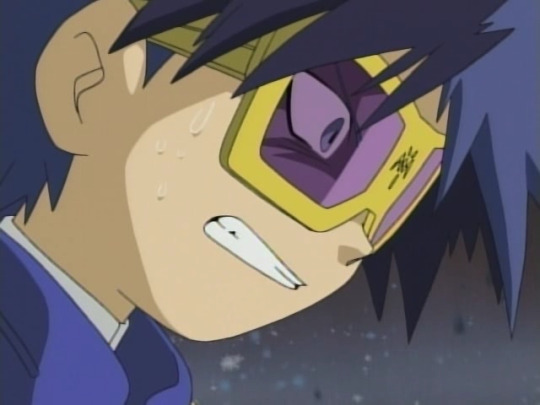
Ken’s journey of redemption is generally well-documented overall, and it was explicit enough in the series that there’s only so much you really need to explain it, but due to the blurred boundary of what was supernatural influence from the Dark Seed and what was Ken’s own emotional problems wreaking havoc, it’s somewhat more difficult to bridge that gap between the Kaiser and Ken, and how they can be the same person.
The easiest way to understand it comes from both directions. One is that Ken, even in his normal element, is much more assertive than he’s often given credit for -- it’s just that the Kaiser is a (fragile) manifestation of that very carefully cultivated to channel that in all of the wrong directions. The other has to do with the fact that the Kaiser is actually really terrible at being a villain, and the persona itself is very fragile and difficult for him to maintain.
Rewatching the first half of 02 shows multiple indications that, for all he seemed to be the stereotype “evil genius”, Ken was forcing himself into the mold. He was never cut out for it from day one. Even from the beginning, Ken’s actual nature as a lonely and inherently kind eleven-year-old child was tearing apart at the Kaiser persona, and the fateful episode 21 was not so much a single turning point for him as much as it was the last straw in a series of things tumbling down for him.
Before we continue: While all of the meta on this blog is only possible thanks to support and input from a handful of friends (whose names will not be disclosed on account of privacy requests), this one in particular arose from a long and extensive discussion with said friends that I am extremely grateful for. As always, I hope I was able to convey your points well.
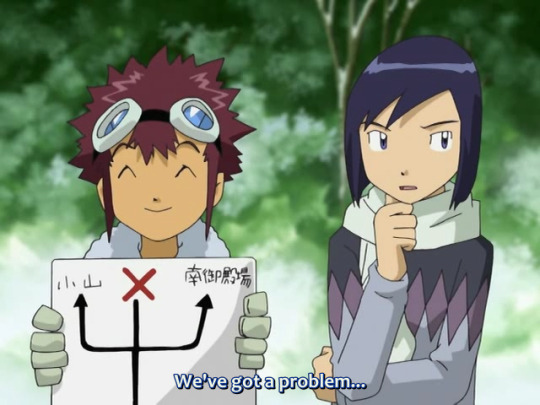
Well, firstly, it’s important to understand that, much like nearly any other character in this series, Ken’s surface demeanor is a bit deceptive. The Crest of Kindness has the original Japanese name of yasashisa (優しさ), which has a secondary meaning of “gentleness” (lost in translation, but still apparent with the bubble metaphor in 02 episode 23). That also ties into the secondary meaning of “kind” -- it’s not just about being naturally “soft”, but actively choosing to be gentle with others even when you’re theoretically capable of not doing so. (For those of you who have seen Appmon, the entire point of that series was about what it means to consciously and deliberately choose to be kind, and, in fact, quite a few parallels could be made between Ken and Haru...)
The contrast between Daisuke and Ken goes far beyond just the surface. Daisuke’s surface demeanor is abrasive, but he’s not actually very good at being assertive until push comes to shove, and he otherwise tends to bend easily to others or get overwhelmed; in contrast, Ken has a more polite demeanor and for the most part seems non-confrontational, but has much stronger control of his emotions and is more easily able to be assertive than Daisuke is. (Of course, both of them share the common point of being like-minded when it’s something that really matters, but Ken is much better at imposing his will and getting what he wants done before Daisuke ever gets to that point, which is what fuels the whole punchline of Daisuke and Ken’s Shopping Carol.)
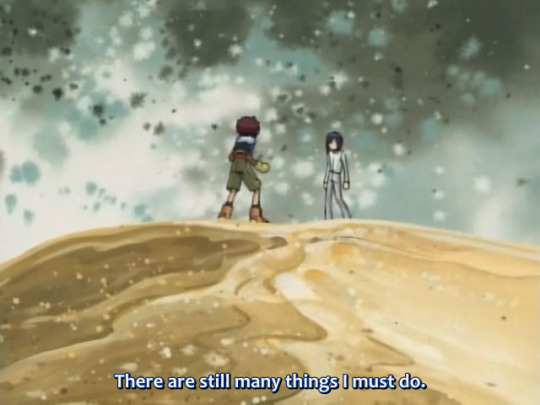
So, the point is: Daisuke is kind out of instinct and just “naturally” being so, but Ken is kind because he consciously believes in treating others well and not causing conflict, and not causing pain to others.
That’s not to say that Ken’s behavior is out of suppression or anything! It’s not a case like Takeru, who’s trying to push complicated emotions down while pretending they’re not boiling under the surface, nor is he like Hikari, who’s compulsively pressing her emotions down out of a desire not to burden others. Rather, even as early as 02 episode 26, he’s very straightforward about what his issue is and what he thinks about it. Ken’s “shyness” during the latter half of 02 is largely due to shame and hesitation from not knowing the other 02 kids well, but as the series goes on and as we go into post-02 material, he indicates that he’s perfectly wiling to be vocal about what he thinks without necessarily fighting any compulsion to suppress it. For someone who claims he doesn’t know much about his own heart, he arguably seems to have the best grip on understanding himself compared to a lot of this cast!
So in essence, the main take-home here is that Ken is theoretically capable of being strong-willed and assertive, and is very good at choosing when he wants to be assertive and when he wants to hold back. And he likes seeing people get along, and he wants everyone to be happy, and he doesn’t like seeing people be hurt or hurting others, and under normal circumstances, Ken has very good control of his emotions for the most part and quite a lot of self-awareness. That’s why Ken is the one to get the unique designation of this Crest; everyone in this cast can be said to be generous and supportive of others in some form, but there’s a difference between being a “natural” doormat who defers to others by default (Daisuke being a very good indicator of how this kind of mentality has a flip side of lack of self-esteem and high insecurity, and Tamers’s Takato being a good indication of how “being deferential” doesn’t necessarily preclude you from having tendencies towards selfishness or cowardice), versus choosing to be kind by understanding everything and still being gentle out of a belief that it’s the right thing to do (again: see Shinkai Haru). And it’s why Wormmon says in the 02 episode 23 flashback that Ken’s kindness can be used against him; being “kind” in this way requires a lot of mental fortitude, strength, and guts, all of which are things that could easily be very bad things when applied in the wrong direction.
This means that all the Dark Seed really needed to do in order to turn him into the Kaiser...was make him lose grip on that self-control.
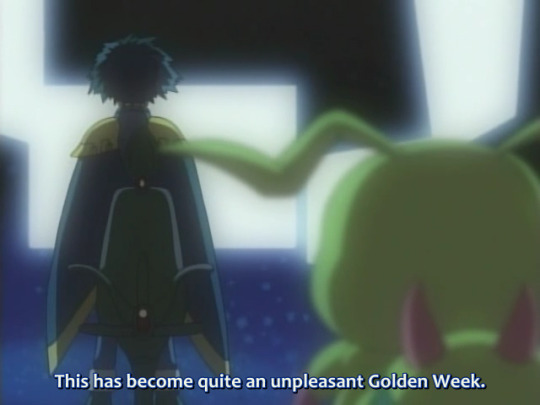
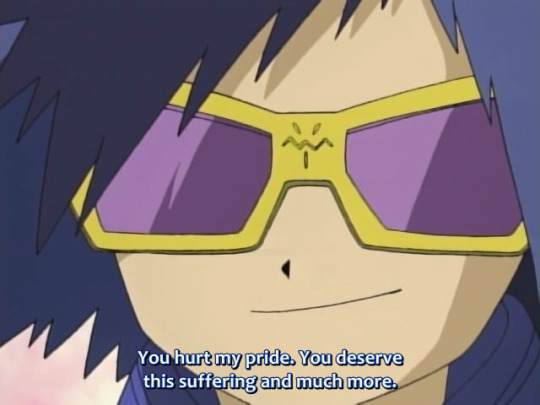
Actually, Ken says it himself in less-than-subtle words in Spring 2003:
…It was revenge. But who was this revenge against? Did I want to triumph over the ones who made fun of me? The ones who looked down on me and used me?
But… In the end, it was revenge against myself. I couldn’t do anything but deny the kind of human being that I was.
So in other words, the Kaiser persona was, effectively, a self-loathing eleven-year-old boy throwing a massive tantrum. A lot of the Kaiser’s actions in the first half of 02 are honestly rather petty -- he’s basically upset at the kids spoiling his holiday in 02 episode 6, he attempts torturing Daisuke out of a petty grudge over a soccer sliding tackle in 02 episode 8, and everything to do with expanding his territory and eventually (hopefully?) becoming ruler of the Digital World is frankly very sloppy. For all he’s said to be a genius, his genius only seems to extend to book smarts, and his “tactical planning abilities” never really expand beyond that of a soccer field sort of affair; his way of locking down control on other things is basically just “brainwash it harder” or “whip it harder” and applying harder brute force instead of doing something in the long-term like, say, trying to rule with charisma and recruiting allies.
(Again, bringing Appmon back into this, seeing Cloud in action will give you a much better example of a charismatic human villain who’s actually competent at his job. Or, heck, you can even look back at Savers’s Kurata, who at least was savvy enough to pull strings with people in powerful positions. Or even the Kaiser’s predecessor Saiba Neo from V-Tamer, who may have been openly sadistic but still had the sense to align himself with background power. Really, compared to all of these folks, the Kaiser is downright pathetic.)
Remembering that Ken fell into the Kaiser persona partially as a desperate attempt to become a “perfect person” like Osamu, Ken “imitated” Osamu’s cruelty to him because he felt that was how he could improve himself to become a “strong” person better than him. But the irony here is that Osamu’s “cruelty” was something that he himself never liked, and mainly came from lashing out at Ken due to feeling like he had a lack of control over his own life. So Osamu was never happy in that position, and Ken, who is indirectly pointed out via the bubble metaphor to be even more fundamentally inclined towards gentleness, is probably even more miserable.


Because everything Ken does as the Kaiser is “unfocused lashing out at everyone”, the Kaiser has less control over his emotions than Ken normally would. Takeru manages to emotionally pin him to a corner by confronting him with enough assertion in 02 episode 19 (this is before he punches him), and correctly points out that the Kaiser isn’t capable of winning with words (i.e. ideologically) and resorts to violence as the first thing he can think of. You’d think that if the Kaiser were actually someone with the self-confidence to consider the other Chosen Children beneath him, he wouldn’t even bother giving them the time of day, but Takeru just happening to be a little assertive is enough to make him lose his composure and start falling apart, and a lot of his shaken “insects!” yelling comes from him seeming pretty desperate to cling onto that rather than being all that confident about his natural superiority over anyone. 02 episode 20 establishes that he’s getting himself in over his head by tampering with the powers of darkness he can’t control, and while, on a plot level, it means that he’s misjudged his own capabilities, on a metaphorical level, it corresponds to the fact that even Ken himself is incapable of getting himself out of the emotional abyss he’s in.
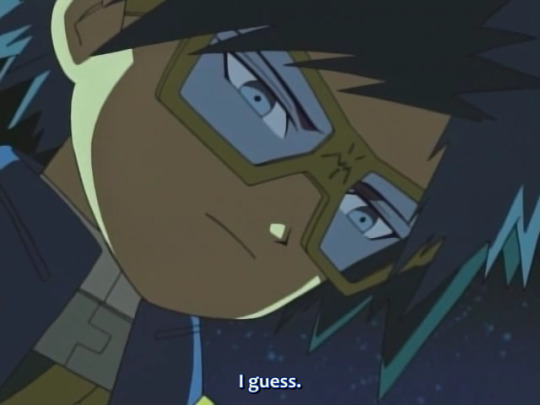
And on the flip side, one of the biggest “tells” that Ken is still miserable during all of this is 02 episode 9, where he’s seen ruminating on the “glory” he’s getting in the real world despite having just decided to leave it all behind. The episode prior, after all, had been called “The Digimon Kaiser’s Loneliness”. The media is using him like some kind of “hot topic”, his parents’ affection (in his mind) is shallow and based only on his achievements, and he has no friends (how much of a role Akiyama Ryou played in his childhood is unclear, but either way, he’s no longer around now). With no emotional support coming from any direction in the real world, he’s resorting to at least trying to have some “fun” in what he perceives to be a “game”, and yet he’s still not having fun at all.
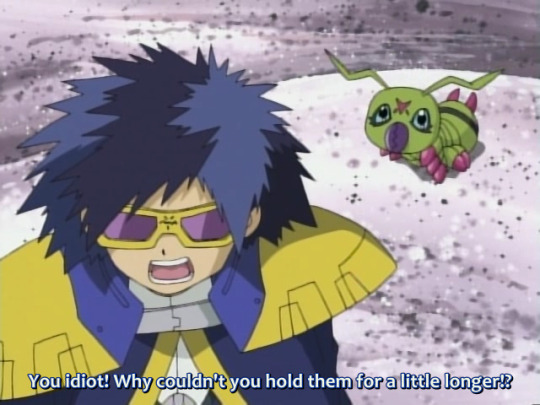

If you look carefully at a lot of the Kaiser’s actions during the first half of the series, one thing you’ll notice is that there are multiple indications that he’s not quite up to par to being as sadistic as you’d think he’d be. Recalling that we learn in 02 episodes 20-21 that the Kaiser is under the impression that the Digital World is like a game that he can “reset” and the Digimon in it not real living beings, it has interesting implications of the fact that he’s actually very hesitant to physically harm other human beings -- he certainly likes emotionally toying with them, but even when he’s trying to take petty revenge on Daisuke in 02 episode 8, he goes out of his way to set up a trap with Bakemon to torture him rather than, well, actually using the kids as hostages. That’s a hell of a lot of work to do, but he instead uses this extremely roundabout way to get them out of the picture in a somewhat less harmful way, risking having them escape (which is exactly what happens).
And in 02 episode 19, when Takeru confronts him and he ends up whipping him, you can hear a slight “...gh?” in the Japanese audio for a split second right after that, meaning that the Kaiser is, for some reason, having a hard time dealing with the fact that he just hit Takeru, and he does a very poor job defending himself against Takeru punching him out despite ostensibly being trained in judo. (Seriously, if you watch the animation of the scene, he’s just lying there while Takeru repeatedly punches the hell out of him, because he’s so out of it.) Regarding the Digimon, he’s convinced himself that they’re not living beings, but regarding the human Chosen Children, who undeniably are, no matter how much he might look down on them, he has a suspiciously hard time harming them as much as he could...
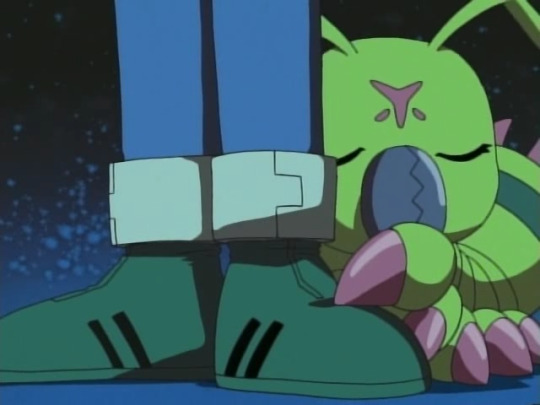
On top of that, one interesting question that might come up to one rewatching the first half of 02 is the strange “contradiction” of why the Kaiser ostensibly seems to hate Wormmon so much, calling him an unworthy idea of a partner in 02 episodes 10 and 19, and yet does remarkably little to get Wormmon away from him or off his case (he hates Wormmon calling him “Ken-chan”, yet doesn’t really try very hard to stop him). He could have easily locked Wormmon away in a cage or something if he really wanted to -- actually, there’s the question, why doesn’t he slap an Evil Ring on him? Because in the end, Wormmon is the only emotional support he’s really getting, and so it’s likely he unconsciously doesn’t want to lose that. Recalling that Digimon are fundamentally linked to the inner self, the Kaiser rejecting Wormmon for being “weak” is analogous to Ken rejecting his own self for being “weak” and “not perfect” -- which means that the fact he still keeps Wormmon around is analogous to the fact that Ken hasn’t really been able to bring himself to completely let his fundamental nature go. And, hence, it’s why he gets so initially incensed at Wormmon’s “betrayal” at 02 episode 10 (and yet still keeps him around despite that), and is ultimately emotionally destroyed by his death in 02 episode 21.
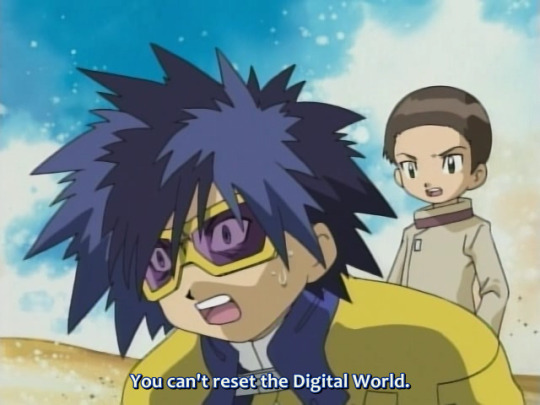
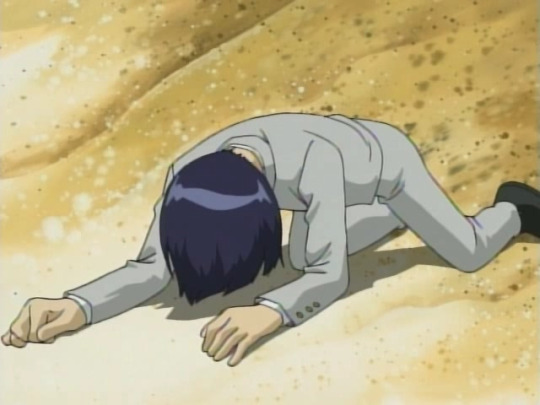

Although, actually, if you look carefully at 02 episode 21, it’s not quite Wormmon’s death that necessarily does it -- the turning point where he sheds the Kaiser persona is right before that (and in case you have any doubts, the animation puts highlights in his eyes for the first time in the series right at that point). Wormmon’s death is the first major consequence of his actions that he has to deal with, but what actually brought Ken back to his senses was his own realization that Digimon are living beings, that his actions have had permanent effects this whole time, and that he can’t take back anything he’d done.
Remember that 02 is a series that is largely about moving on and accepting that you can’t change the past, and that you have to move forward regardless of that. Ken’s fall into sadism was only possible by driving him into extremely deep-seated denial -- he was already starting to face the potential reality of Digimon being real, existing beings in the real world an episode prior. He says, outright, in 02 episode 21, that part of the reason he came to the Digital World to do all of this was escapism -- and, presumably, under the idea that any mistake he made could be rolled back and redone, unlike Osamu’s death. But the Digital World is not a place you can reset like a game, Ken will have to live with the consequences of his actions again, and moreover, every single one of the actions he’d been convincing himself were relatively meaningless had caused severe and permanent harm, and the entire thing overwhelms him.
It’s also important to point out that this was probably where the Dark Seed had to work a lot of magic to get Ken to embrace this kind of denial so easily -- after all, it’s established in the final quarter of the series that it does have a tangible impact on personality and puts a damper on one’s ability to feel empathy. In the flashback in 02 episode 23, regardless of whether Ken considered the Digital World to be a “game” or “able to be reversed” or not, he clearly still didn’t care and treated those around him with proper kindness (even if he did consider it to be all of that, it probably wouldn’t have been entirely unlike how a lot of us have a hard time picking rude choices in video games). It’s a very complicated chain reaction of events that allowed this to be even possible, and it was so against his fundamental nature that once the denial broke and Ken reached his limit, he wasn’t able to do it anymore. The Chosen Children’s main role in 02 episode 21 was really just cleaning up the massive mess he’d made in the form of Chimeramon, but as far as the whole thing about the Kaiser’s persona completely falling apart and Ken being forced to confront his own self goes, that was pretty much all Ken and Wormmon, in a series of dominoes that had already been collapsing for episodes on end.
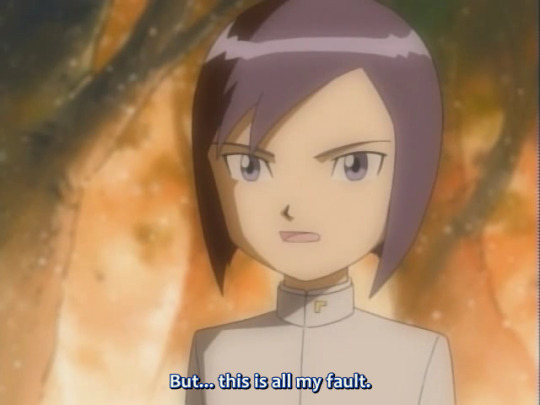
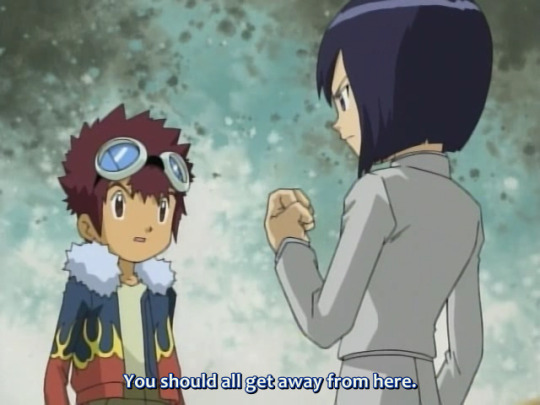
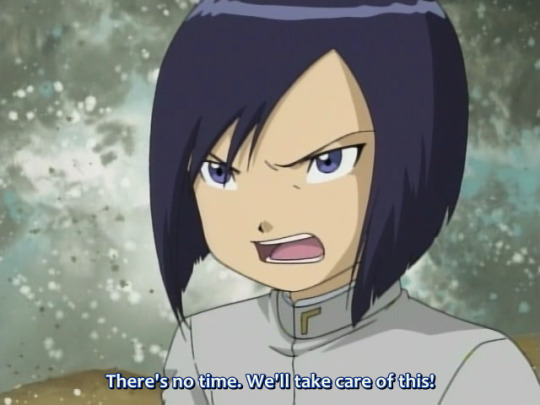

The following episodes have Ken treat the 02 team with a certain amount of detachment, and this is often construed by a handful of people as being reflective of Ken being standoffish of some sort. The fact that Daisuke and Ken are often promoted in franchise materials as “rivals” mainly due to them being in the “protagonist and right-hand-man” position such characters are in might tempt you to think that way, but they are most definitely not!! (Considering that even saying that Taichi and Yamato fit that mold is a bit questionable, and neither Ruki nor Jian quite fulfill the expectations of the role in regards to the genre-subverting Tamers, Frontier, which is explicitly said to be deliberately written to be conventional, is probably the first proper execution of this trope in the form of Takuya and Kouji.) Ken’s detachment from the group at this time in the series is something he actually gives the reason for quite directly: he believes it’s his fault and doesn’t want to burden them with what he considers to be his job, and in the end Daisuke ultimately breaks through to him and they become completely normal friends who get along. “Rival” what?
Ken is, at worst, distant during this point of the series, but he’s actually very straightforward about what he wants and intends to do; it’s just that he’s being a bit blunt about it because he’s still drowning in his shame and not sure how to approach them. (Also, consider the fact he was rather lacking in friends or a support group before all of this; he doesn’t have a lot of experience in socializing, either.) So he keeps everyone at arm’s length, and the reason he comes off as so standoffish is because he’s so assertive! He directly and bluntly makes some very strong remarks about how he believes everyone else shouldn’t be getting involved! Again, when left to his own devices and not being manipulated into by a supernatural evil seed into multiple levels of denial, Ken is very in control of what he wants and thinks, and is even very open about speaking his mind.
That’s even when they’re not good decisions, mind you. Ken starts off the climax of 02 episode 26 being very firm about wanting to suicidally throw himself into the reactor in order to stop it, and 02 episode 30 has him consider himself a burden to the team after the fallout with Iori and try to stay out of it despite them very badly needing his presence, which Daisuke (of all people!) rightfully calls him out for being childish about. But he also listens to reason very quickly and acknowledges the others’ point very easily, with Daisuke reminding him in 02 episode 26 that his suicidal recklessness is actually pretty self-centered and short-sighted of him, since it’ll prevent him from doing anything else to take responsibility for his actions going forward, and Miyako, uh, slapping him in 02 episode 30. (But he comes quietly right away as if acknowledging his own idiocy, and never holds it against her thereafter.)
Nevertheless, the point is: you can see that this kind of assertiveness is the same kind of assertiveness he had as the Kaiser, just channeled in a different direction and for a different purpose. But as the Kaiser, he was angrily lashing out at anything and everything and stepping on anything he could just so he could have a show of power; once he comes back to his senses, he reserves that force for it being something he consciously believes is the right thing to do (regardless of whether it’s actually the right thing to do or not).

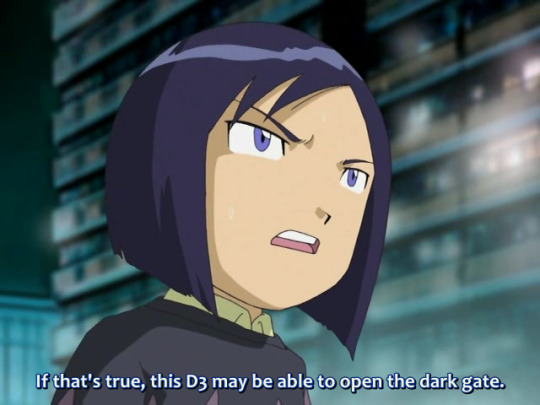
Because of the fact Ken spends a lot of the last quarter of 02 suffering and parsing a lot of trauma, a lot of people have tended to pin him as constantly sad and being a soft crybaby, but that couldn’t be further from the truth! Despite all the emotional pain he goes through, Ken has a hell of a ton of strength through all of this -- he even flings a well-aimed quip at Oikawa in 02 episode 44 despite being in a completely helpless situation, and in 02 episode 45 he himself is the one who volunteers to open the gate to the Dark Ocean, despite knowing exactly what it entails. That takes a lot of guts, and all things considered, his recovery from being the Kaiser spans only four months and is altogether incredibly fast given what he went through -- it did not take long for him to regain his bearings and get himself back on track. Again, it’s the same kind of “assertiveness” and capacity for action that fuels what the Kaiser did, just better controlled and in a direction Ken knows he actually wants.
This is also why I tend to object to insinuations that Ken would be overly touchy about or traumatized by the mere discussion of him being the Kaiser in the aftermath of 02, because the series itself, multiple times, portrayed him as being very able to talk about his experiences bluntly and honestly, at worst maybe considering it a bit of an awkward topic. He has no problems admitting that it was a thing that happened, especially if it involves discussing it as part of taking responsibility or preventing further damage -- it’s just that he of course doesn’t enjoy it either, and is equally as open about the shame he feels as a result. All of the times Ken loses his composure in the latter half of 02 involve either physical pain being inflicted on him, or a lot more actively vicious invocation of his memories and insecurities, and even then he gets himself back on his feet with a rather prompt amount of speed. Poorly timed of a statement as it may have been, Miyako is not incorrect when she says in 02 episode 31 that he has a certain amount of natural resilience that he carried from being the Kaiser.
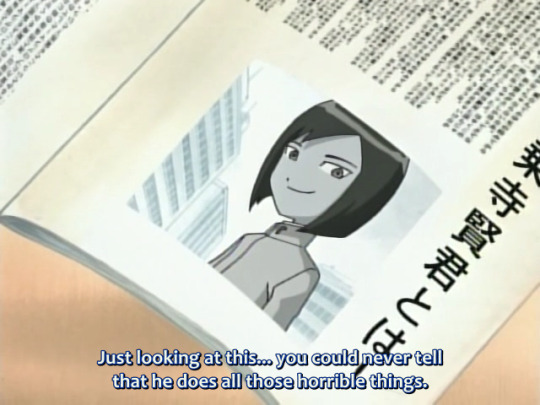

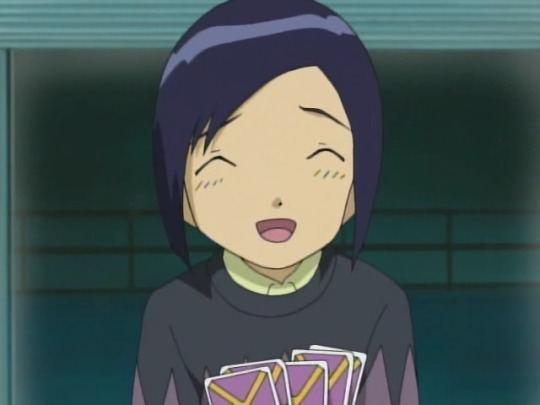
All the way back in 02 episode 9, shortly after it was revealed to the group that Ken was the Kaiser, Iori, Hikari, and Takeru all label Ken as someone who doesn’t look like someone who could do something so horrible, and Hikari even says that his smile looks “gentle” (note that this is yasashisou, a word derived from the same root word used for his Crest). So in other words, even all three of them were able to catch on to his actual nature betraying himself even during that awful period of time. It’s still poking through, all things considered.
But we as the audience know he’s putting on that face for the camera, and his eyes are still as dead-eyed as they are for the first half of the series, and when Miyako accidentally makes him laugh during the Christmas party in 02 episode 38, it’s very much framed as probably the first time Ken has been this genuinely happy in a long while. He was never able to be this happy even when “satisfying” himself by stepping on others as the Kaiser.
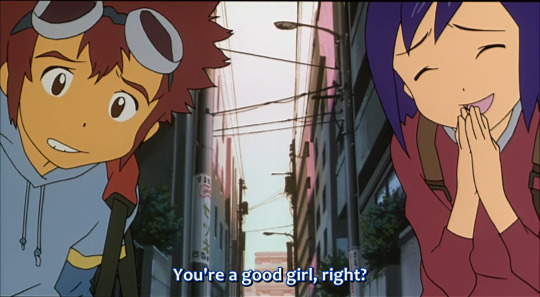

And that’s why it’s so extremely unlikely that Ken will ever be able to lapse back into the Kaiser persona after the events of 02, even with the Dark Seed technically still inside his neck. He wasn’t enjoying it anyway; the Kaiser persona wasn’t a habit that he fell into out of emotional suppression or even catharsis, but rather him forcing himself into a role he was never comfortable in to begin with. He was never truly satisfied with anything he was getting out of it, and moreover, it took the combination of supernatural influence and a hell of a lot of denial to allow it to get that far in the first place, because of how far against his fundamental nature that was. (Again, for those of you who have seen Appmon: think about what it would take to get Haru to embrace sadism.) Even Osamu wasn’t enjoying being cold; being kind and living your life with positivity is a lot more fulfilling and fun, anyway.
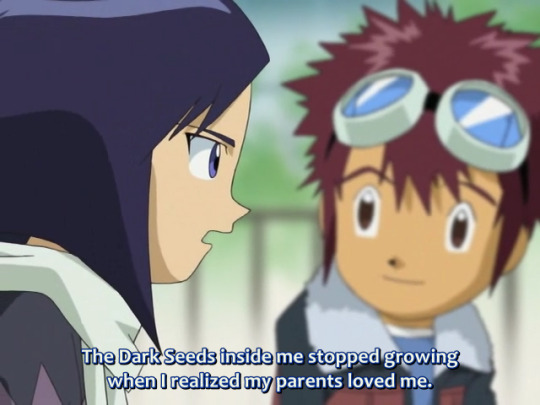
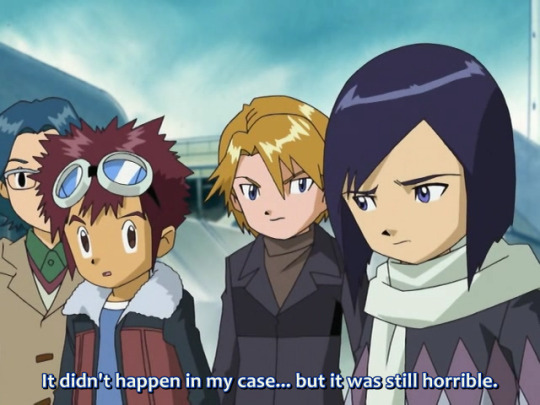

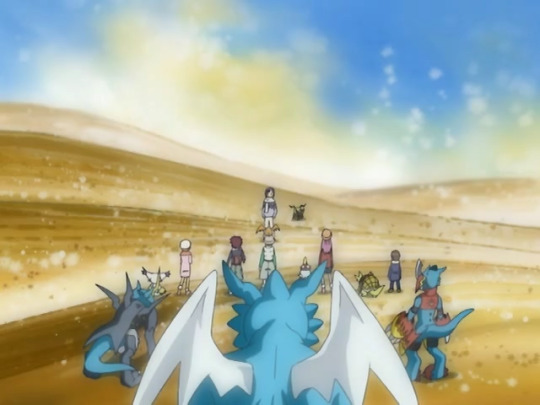
In 02 episode 48, Ken describes the influence of the Seed as “horrible” in retrospect; even if it didn’t involve physical pain and exhaustion the way it did for the Dark Seed children, the entire experience sucked even back then. And while Ken theorizes about the Dark Seed’s influence being countered by the power of love earlier in the episode, when you look at the whole of 02, it’s not just his family’s love -- Ken now has the emotional support of his family, and Wormmon, and his newfound friends, and that’s giving him all of the fulfillment he wanted that putting on a front of sadism wasn’t giving him, and he doesn’t really need anything else anymore.
02 itself is very much about the fact that it’s not a bad thing to rely on the support of others to be happy; the Ken and Kaiser are undoubtedly the same person, but the latter’s existence requires a very specific lineup of events and factors to happen, and one of the massive parts behind that was a severe lack of emotional support or anyone who properly understood him. And by the end of the series, Ken has more than enough strength of heart to accept everything that’s happened and move on, and to stop reaching out to denial and clinging onto the past, and he has emotional support and understanding from a whole new group of friends that thoroughly understand everything he did and went through, and wholeheartedly accept and love him anyway.
He is never going to have a gaping hole in his life like that again.
170 notes
·
View notes
Text
Why Amon Should Have Been An Android
(spoilers for LoK and Young Justice season 1)
If you followed my LoK liveblog at all you may have noticed that I theorized at one point or another that all four major villains of LoK (Amon, Unalaq, Zaheer, and Kuvira) were secretly robots/androids (the term I used was robot, but the more accurate term would have been android.) Now, with Unalaq it was definitely just because I found him boring, with Zaheer it was to make fun of the fact that he was an Airbending prodigy with zero training, and with Kuvira it was because it was a thing at that point for me to predict that an LoK villain was a robot (and I was kind of right that time!!)
But with Amon? I was completely serious. We never see his face, his cause is stupid (and the perfect way for his programmers to start some trouble in Republic City), and he was able to resist bloodbending, which, if you’ll recall, requires that the victim have blood for it to work. You know who doesn’t have blood? That’s right, androids/robots.
But there’s another reason that I sincerely thought Amon was going to be a robot (android), and it’s the reason I’m writing this. There was something naggingly familiar about LoK to me, and no, it wasn’t that it was a sequel series to ATLA. To me, LoK doesn’t really feel a lot like ATLA (barring, of course, the very poorly shoehorned in fanservice cameos of Iroh, three times, like he’s a recurring character or something.) I struggled to pinpoint exactly what it was, but in my own observations and the observations of other people that I was talking to while liveblogging, a couple key differences became clear:
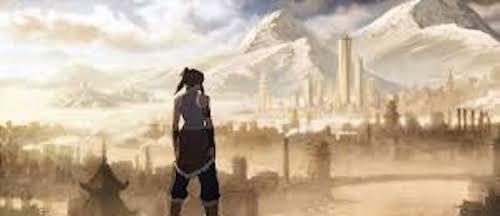
[ID: an image of Korra from the back looking out towards Republic City, which is shown to have large white skyscrapers, a bay, and numerous smaller buildings. Much of it is obscured by fog and clouds. The city is built in the middle of a sprawling bay. /End ID]
1. the setting of LoK is incredibly Americanized and Eurocentric. While ATLA displays a lot of cultural insensitivity towards the cultures it borrows from in choosing how to depict them, LoK...doesn’t really depict other cultures. Republic City to me felt very similar to how 1920s New York is typically depicted in media, and no setting in the Earth Kingdom or Water Tribe was explored enough to really explore the unique cultures of those settings. While you can tell in ATLA that bryke was somewhat interested in (a vague, exoticized, unrealistic vision of) East Asian culture, LoK is very clearly inspired by America and Europe, with very little else influencing how the setting was depicted.
2. there are no “unimportant” people in LoK. Everybody is related to somebody we know from ATLA (or somebody from ATLA), a powerful business mogul, military, somebody high up in the government, a celebrity, and/or the Avatar. The only character I can really think of that’s an exception to this is Kai, who really does not have much of a role. (I guess you could argue that Mako is an exception but y’know...he was a famous pro-bender for a while there) You don’t just get to meet a regular person living in a village anymore. Every character in LoK has political, social, or cultural power.
These points, put together with the technological prowess of the world of LoK (which is different season to season and sometimes even episode to episode depending on how the writers are feeling that day), made the show feel very distant from ATLA, but very, very close to another show that I have watched and loved. And that show is Young Justice.
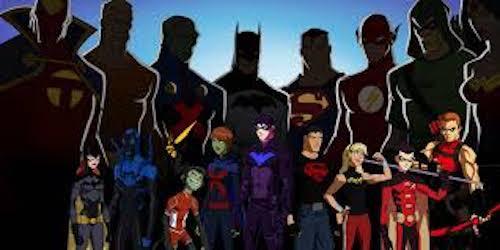
[ID: an image, from left to right, of Batgirl, Blue Beetle, Bumblebee, Beast Boy, Miss Martian, Nightwing, Superboy, Wondergirl, Robin, and Red Arrow in the foreground, posing together. Above them and in the background are the adult heroes, obscured in shadow. From left to right, Red Tornado, Aquaman, Martian Manhunter, Batman, Superman, the Flash, Green Arrow, and Wonder Woman. They are all against a gradient blue background. /End ID]
For those not in the know, Young Justice is a DC animated cartoon focusing on the teen sidekicks, proteges, and relatives of superheroes like Batman, Superman the Flash, Green Arrow, Aquaman, Martian Manhunter, and others banding together to form their own superhero team. YJ is set in America, vaguely, with characters residing in cities with names like Gotham City, Star City, and Central City (a naming convention that Republic City fits right into). And as is apparent from the premise, most of the characters you’ll meet in YJ are superheroes, related to superheroes, or otherwise important business moguls, celebrities, or political figures. And while the world of YJ is of course significantly more technologically advanced than that of LoK, there’s more overlap than you’d think. Besides spaceships, teleportation, smartphones, and genetic engineering, there’s really not a lot of tech that YJ seasons 1 and 2 have that LoK doesn’t.
So you may be thinking, “ok Arthur, we get it, you’re a fucking nerd, what does this have to do with robots?” I’m glad you asked! One of the storylines of YJ focuses on the war between rival tech moguls Tio Morro and Professor Ivo, in which they build increasingly sophisticated androids. Ivo’s are pretty much just designed to kill supers, but Morro’s are expressly designed to mirror the human psyche, and desire to be a part of human society. Amon very clearly also desires a community, and does much of what he does to integrate himself into a community of nonbenders where he really doesn’t belong. Further, Morro’s androids are immune to threats that humans are not immune to because they are not made up of organic matter. For example, in season 1, episode 3, Miss Martian attempts to read Red Tornado’s mind, to no avail, because she can only read the minds of organic beings. In a similar vein, Amon was able to resist bloodbending, and while unfortunately that was not because he was an android, it would have made sense given the conventions of the cartoon android genre. I didn’t realize it at the time, but my previous YJ knowledge very much influenced the way I read that scene. The way Amon’s body was animated very much mirrored the animation of Morro’s androids trying to resist their evil creator’s programming.
So, I’ve taken you through the what, the how, but I promised that I’d say why Amon being an android would have been better, and I plan to deliver. First, it needs be remarked that while Amon being an android wouldn’t have made much sense, it would have only made slightly less sense than the canon explanation of Amon being Tarrlok’s secret brother. In fact, I’d argue that, if handled correctly, Amon being an android could make more sense and be more impactful. Here’s how I envision it: android! Amon would be pretty similar to Red Tornado, in that he would know that he was an android and be programmed to help people. He was of course, built by Hiroshi Sato (that man designed and likely built all the Equalists’ weapons he has the range), who sees himself as a sort of father to Amon. Hiroshi tells Amon about the systemic disenfranchisement of nonbenders and how a Firebender killed his wife, and Amon, being programmed to want to help people and to desire participation in human society, decides he wants to lead a revolution against benders. However, an android can’t very well openly lead a revolution (you could add a bit in the backstory episodes about how humans don’t trust androids or something), so Hiroshi and Amon come up with the story that Firebenders burned his face and hands, which is what prompted him to lead the revolution. Thus, his whole body, including his face, is covered, and his followers assume that it’s because the burns are so bad, and they follow him. In the latter half of the season, the krew would uncover Hiroshi’s involvement with the Equalists, but Asami would be the one to realize that Amon is an android that Hiroshi built. Amon being Hiroshi’s “son” of sorts would be another element of Asami coming to terms with the evils of her family, as Amon in this case would be a machine programmed to be easily manipulated to follow Hiroshi’s cause and would consider himself her brother, and she would have to reckon what to do with both of them. The nonbenders’ cause would still be legitimate after Amon was exposed as an android (unlike it is when the literal figurehead of their movement is also antithetical to their movement) and the heroes would have to reckon with the realities of bender supremacy and the hurt it caused. Amon could even get a redemption arc and work with world leaders to make a better society for nonbenders and androids like himself (I’m sure there’s some parallel you can draw between nonbender oppression and android oppression, though I can’t think of one atm) As an added bonus, Amon wouldn’t be able to bend, so he couldn’t bloodbend Korra, which would be one less time that an LoK villain took away Korra’s bodily autonomy. Amon could even be a recurring character in the later books, because really, wouldn’t LoK have been more fun with a newly-redeemed android sidekick still learning about what the world is outside of his creator’s narrow worldview? Plus, that would give Asami more to do in books 2 and 3 than meet Varrick and participate in love triangle drama (Amon is of course replacing Varrick’s presence on the show), and getting to know and bond with Amon could be the catalyst for her visiting her father in prison in book 4.
Remember, I didn’t claim that this would be good, I claimed that it would be better, and since the bar was on the ground with that secret brothers twist that wasn’t too hard to accomplish. tl;dr bryke are cowards, take the plunge and make him an android.
#still don't understand why bryke cut pro bending after b1#it was genuinely brilliant#i know amon's not a bender but i would want him to be involved in a pro bending storyline post book 1 somehow#longpost#meta#ehhhhh is this a meta tho?#genuinely kind of a stupid meta but once my brain made the republic city star city central city gotham city connection this genuinely#would not leave my brain until i made it#amon#lok#idk honestly i feel like what i wrote is actually more thematically appropriate for an atla sequel series#like found family and redemption and that junk#plus asami could potentially get an arc#if i were writing it she'd get an arc#well generally if i were writing the show asami would get an arc but also specifically with this android thing#tbh if you ask me how much of this is a joke i couldn't even tell you#it is a thing that exists and you can interpret it as a high effort joke or as sincere#it's 2020 cringe is dead
49 notes
·
View notes
Note
POST THE FUCKING ESSAY KOAL/DUSTY I SWEAR TO GOD
WAIT I THOUGHT YOU READ IT ALREADY??? DID I SERIOUSLY NOT SEND IT TO YOU WHEN I INITIALLY FINISHED IT??? GOD WHAT THE FUCK
Well I can’t NOT post it now.
So for some background, the assignment was to write a short essay arguing as to why a children’s series of our choosing could be classified as horror, based on some article we had to read. I chose Wow Wow Wubbzy because I thought it would be funny and. man. So anyways this is VERY poorly written because I did most of it between like,,, midnight and 3 am. It’s very ranty and way longer than it needed to be. For ease of reading I went back and fixed up the shitty formatting and fixed a few spelling errors, as well as linking my sources.
So uhhh this is about horror so,, warning for horror ig?? It’s not scary like, at all, but better safe than sorry.
Wow! Wow! Wubbzy!: The Horror Within
Introduction
“Wow! Wow! Wubbzy!” is an American TV show originally aired on Nick Jr. From the mind of Bob Boyle, this educational kid’s show was very memorable for a lot of kids growing up at that time. The show features Wubbzy, a yellow, square, animalistic character, with a curly, “springy” tail; as well as Wubbzy’s various friends. Most episodes feature Wubbzy and his pals, Widget and Walden (as well as Daizy in later episodes), dealing with an every day situation, or well, depends on your definition of “every day”. The situation spirals out of control because of the actions of various characters, and it is resolved by the problematic character of the episode learning a lesson and fixing their mistake. Seems like a typical kids show, right? Well, there may be more to it than that. What if I told you that Wow! Wow! Wubbzy! could be interrupted as a horror show about horrifically mutated beasts struggling to survive the post apocalyptic world they are forced to inhabit? Wow! Wow! Wubbzy! fits many categories described in Sharon A. Russell’s literary criticism in “What is the Horror Genre?”. In this essay we will discuss how Wow! Wow! Wubbzy! could possibly be classified as a horror series.
Asking the real questions; what is everyone?
First of all, a very important question. What exactly are the characters? There are claims that Wubbzy himself is some kind of gerbil, but frankly I don’t see it. Also, what’s the deal with the inhabitants of Wuzzleburg in general? Wubbzy and his friends are supposed to be anthropomorphic animals, but they seem more like horrific monsters, mutated from normal animals. Monsters are a very common and important element in horror. Not all monsters are vicious killers, and not all of them are obvious in appearance. Some monsters are small and cute, but it’s almost always a facade.
There are also some “regular” animals running around, but yet they aren’t “normal” by any stretch of the imagination. Some are very obviously not normal, others seem mostly normal. “Flutterflies” are a common, non-anthro animal seen in Wubbzy, with their most prominent appearance being in the episode “The Flight of the Flutterfly”. Flutterflies seem like normal butterflies, but why are they called “Flutterflies” instead? Are they in any way different to the butterflies of our world, or is that just what the inhabitants of Wuzzleburg call butterflies? What about the more blatantly odd non-anthro animals? In “Attack of the 50 Foot Fleegle” Wubbzy acquires a pet “Fleegle”. It appears to be a small, purple, almost hamster like creature. It remains small and happy if you feed it the right kind of food, but Wubbzy foolishly feeds it candy and sweets. When fed candy, the Fleegle increases in size in increasingly large increments. After a time, it becomes so big that it rampages all over Wuzzleburg. The only thing that could shrink it back to normal size was carrot juice. When fed bologna, they multiply, and the solution to this is unknown, as the episode ends there and this is never brought up again.
There are plenty of strange animals, both anthropomorphic and not; yet no humans. Not a single human character in sight. This begs the question, what happened? Why are all these animals how they are? What happened to the humans? Obviously, these questions were never answered, as this is a kids show. Here is a thought to consider: what if all the humans are dead, and all the characters are mutant abominations, or, monsters as they’d more fittingly be called. Humans have been wiped out, and the animals who survived mutated in many different ways. Some animals became intelligent, and capable of building their own society similar to what once was our own. That society is what we know as Wuzzleburg. In conclusion, all the creatures seen in the show are the result of something terrible; mutated abominations passing as animals. This fits the “monster” category of horror as described in Russell’s article.
What’s the deal with Wuzzleburg?
Wow! Wow! Wubbzy! takes place in the fictional town of Wuzzleburg. Wuzzleburg and its surrounding locations look very odd. Everything is unnaturally geometric. Everything- from houses to trees- is very odd in appearance. Tree branches are often bendy, always at a right angle, with the edges being smooth and rounded. In Wuzzleburg, many houses look like completely normal houses, yet Wubbzy lives in a tree house. Another common thing is that houses and buildings of importance are usually designed based on a specific object. Daizy’s house, for example, is shaped like a flower.
Outside of Wuzzleburg, the locations only get weirder. There is an island, shown to be somewhere off the coast of Wuzzleburg, called “Dino Island”. As the name suggests, this island is inhabited by dinosaurs. So apparently, dinosaurs are not extinct in this universe; at least on this island. As far as other towns go, there is Wuzzlewood, clearly based on Hollywood, where all the biggest celebrities in the Wubbzy cinematic universe (WCU) live. Everything in Wuzzlewood is covered in stars, a clever spin of the celebrity theme. Another interesting location is Plaidville. In Plaidville, everything is plaid; the trees, the ground, and even the inhabitants. I don’t have to explain what is unnatural about that.
Now, back on the topic of Wuzzleburg, since it is the main location seen in the show, and is where Wubbzy and his friends live. It has been stated that Wuzzleburg was founded in 1853 by “Heinrich van Wuzzle”. The specific year being given is an odd detail, that you wouldn’t normally expect in a show of this nature. Wuzzleburg is clearly a town in every sense of the word. It has plenty of stores and restaurants, an airport, houses, residents, a mayor, a rich history, annual festivities, reliable transportation, schools, and even a stable economy. All of this being made by what we have already established as horrific monsters. That’s impressive. There is common debate in the Wubbzy fandom on whether these locations are in a parallel universe, or perhaps if they exist on our Earth. In the episode “Fly Us To The Moon”, the place where they land back on “Earth” appears to suggest that Wuzzleburg is located somewhere in or near Washington state, in America, or possibly somewhere in British Columbia.
My theory is that the events of Wow! Wow! Wubbzy! takes place on Earth, but certainly not our Earth. An alternate Earth, where humans may have lived before. Some horrible nuclear accident wiped out all human life, and caused all the animals to mutate into the many strange creatures of the WCU. This also explains the unnatural features of the setting. Post-apocalyptic Earth? Sounds like a perfect horror setting to me. This fits perfectly with the criteria described in Sharon’s article.
The beast within; Wubbzy’s true villain
Finally, the matter of the deep internal conflict hidden deep within the show. In the show, you can expect every episode to have a lesson or moral, as many kids shows do. Most episodes feature one of the main characters (almost always Wubbzy) making a mistake, followed by them learning the lesson of the episode and using their newfound knowledge to make things right. What if I told you that this is sign of a much deeper internal conflict going on far beneath the character’s cute exterior? Would it be so far fetched to believe that every episode is focused on the anthropomorphic abominations struggling to fight against their beastly instincts? Their own organized and civilized society goes against their very nature, and they constantly fight to uphold the standards they set; both for themselves, and each other. It's a constantly uphill climb. Wubbzy is undeniably a flawed character. He messes up constantly, often learning the same lessons over and over again, as if it’s more of a reminder than a lesson. It’s Wubbzy against himself. This fits Sharon’s criteria of internal horror, but that’s not all.
Wow! Wow! Wubbzy! is also the story of a quest for self improvement, as well as a good vs evil scenario, which are two of Russell’s other criteria. I mean, think about it. Every character is open to self improvement once they realize the harm they’ve caused. Every character is on their own quest, seeking to better themselves. Every character is going through their own internal battle. They fight their own flaws. Their own evils. The true villain of Wow! Wow! Wubbzy! is the evil within all of them, the beastly instincts lurking within all of Wuzzleberg’s monster inhabitants. And they may not always be perfect, maybe they don’t know how to be “good”, maybe being good just isn’t in their nature; but they try their best despite all the challenges, to be better, and improve themselves.
In that way I think we can all relate to them. We aren’t always “good”, we aren’t perfect, sometimes we don’t know how to do the “right” thing, but our flaws are what make us human. It may not be in our nature to be flawless, but it is in our nature to seek self improvement, and that’s what Wubbzy is really about. The struggles we all go through to be better people, because inside? We’re all just monsters trying our best to be civil, and conform to our moral code. And really? That’s enough.
Conclusion
Wow! Wow! Wubbzy! is undeniably a kid’s show at heart, but if you really stop to analyze it, you find a much darker horror series. It would be fittingly classified as a psychological horror. It fits almost all of Sharon A. Russell’s criteria as described in the article “What is the Horror Genre?”. What is Wubbzy? In fact, what are all of the show’s characters? Their vaguely animal appearance appeal to young children, but I believe that they may actually be normal animals mutated into horrible monsters. Freaks of nature created by a nuclear incident. There is not a single human seen in the show, but plenty of abnormal creatures. This suggests that we are long gone. The monsters we left behind built their own society.
Not only were the animals affected, but also the earth itself. The odd nature of the setting supports my nuclear devastation theory. Finally, is the true conflict of Wubbzy. The show itself is about nuclear monsters trying their best to adapt to the society they built for themselves, even if it goes against their own nature. It’s beasts on a quest where the only objective is the betterment of the self. An internal conflict. There is no physical villain in the show. The only antagonist out to get Wubbzy, is Wubbzy himself. In that way, I think we can all relate. In conclusion, Wow! Wow! Wubbzy! is actually about horribly mutated animals fighting their inner demons, on a metaphorical journey to be better than they are. For that very reason, I believe it could be interrupted as a horror series.
Sources:
Wubbzy Wikipedia page
Wubbzy Fandom Wiki, which I did NOT know existed before this project and honestly the comments on the page were the funniest fucking thing, I highly recommend it
And uhhh various episodes of Wubbzy I had to watch
I apologize for my crimes
12 notes
·
View notes
Text
The Swordsman of Time
SSSS.Dynazenon: I'm excited for this. I didn't blog my thoughts on SSSS.Gridman, as I hadn't finished the original back then, but suffice to say it's an excellent series. Let's get started. Major characters; Asanaka Yomogi, whose working part time; Minami Yume, rumoured to be asking guys out only to ditch them. Characters they hang out with; Yomogi hangs around with Awaki, Nazumi, Ranka and Kaneishi, and works with Inamoto-san at the convenience store, Yume spends time with Mei. Gaumu appears briefly. Yomogi seems to be interested in Yume after hearing the rumours. Asugakawa Chise is sat at Yamanaka Koyomi's house, she's ditching school and he's unemployed. Yomogi runs into a starving Gaumu and gives him food, Gaumu feels indebted to him, identifying himself as a Kaiju user. Items start floating. Yomogi dislikes Kamijo, a man his mother seems to be dating, discarding and offer of money, Yume has a deceased sister, Kano, and finds a pair of interlinked black and white Venus charms. Yomogi keeps running in fear from Gaumu, and runs into Yume, who asks to meet him that night. Yume doesn't show, but Gaumu finally catches up to him and decides as payback he'll find her for him. He starts berating her for breaking promises, Yomogi arrives at the scene and she confirms she was tricking him, and that something is wrong with her. At this point the Kaiju Charbandes appears. Gaumu is unable to control it, and pulls out an item. A wire mesh figure appears and reaches out to the three of them, then at Chise and Koyomi watching nearby, capturing Koyomi. The 4 captured find themselves in individual cockpits, communicating via screens. Gaumu identifies DynaZenon, and the figure resolves. After some combat lead by Gaumu, they stop what looks like a final attack by converting to DynaRex. After defeating the Kaiju, Yume reiterates that there is something wrong with her.
Heroes' Odyssey: We start a look at Battle in Hyperspace.
Saber: Rintaro tells Mei he will fight with Touma, but he needs to deal with some loose ends with Sword of Logos first, his face hardens when he leaves. Master Logos seeks a book kept in Northern Base, and is now prepared to have the Ryoga and Reika eliminate the other Swordsmen. At Northern Base they decide Rintaro is probably attempting to identify the traitor, but they can't get into Southern Base, however Yuri can take Touma via the route Tassel took. Rintaro follows Reika to the room Sophia is held, able to listen in and confirm she's there, apparently the boon they want from Sophia has the secret of creating humans. As Touma and Yuri arrive at Southern Base, Rintaro reports Reika's treachery to Master Logos, who instead reveals his goal and that he disposed of the sages. Rintaro, distraught, intends to stop him, but is blocked by Ryoga, who uses Ocean History to become Durandal. Durandal's abilities disorient Rintaro, and start affecting Touma as he enters Southern Base. Touma find Durandal and a beaten Rintaro, and becomes Elemental Dragon. Touma is able to instinctively dodge Durandal's strikes by becoming the Elements, though isn't aware of it directly, forcing Durandal to use Rintaro as a hostage, leading Touma to surrender. Rintaro is distraught that the cause to which he has dedicated his life to is a lie, and tells Touma to destroy Sword of Logos rather than worry about him, but admits immediately he didn't mean it. Promising Rintaro that they will rebuild Sword of Logos, he surrenders Rekka and the Books, but when Durandal steals them by his powers and prepares to kill Rintaro anyway, Saikou interferes, allowing them their opening to escape, but Durandal teleport stabs Touma. Kento breaks into Sophia's cell and reveals his identity. As Yuri fights, Rintaro changes as well, Touma handing him Elemental Dragon, which overflows his water powers allowing them to escape. They get Touma to Northern Base, and while Yuri can heal him with time, they're sitting ducks without the barrier. Which is when Sophia reveals her presence there once more.
Zenkaiger: Vroon clarifies that he never met the Isao and Mitsuko rumoured to have been at Ijirude's lab, and has no idea what they looked like. Kaito and Yatchan now feel worse about their disappearance, with it now sounding more likely they're gone, but Kaito decides to ask how Vroon got there from Kikaitopia. Bokkowaus is furious about the escaping Worlds, and Ijirude goes to seek a remedy, while Barashitara goes to attack. Vroon takes them to where he entered Kaito's works via the Parallel World Gate, but before they can do much Sushi World appears. Kaito is distracted as they fight, and so him and Zyuran get pressed into Sushi together. The others make a plan to save them by luring out Sushi World via their own Sushi. Kaito and Zyuran talk about Kaito's parents, and Zyuran admits he's lost his own parents. The trap for Sushi World works, but Barashitara arrives. Secchan let's Kaito know they're in trouble, and Kaito attempts to change but accidentally uses the Kyuranger Gear, triggering luck that breaks a nearby fire hydrant that sprays them away. After arriving they change, and the Zenkaiser/ZebakiZyuran nigiri handles Sushi World while the rest fight Barashitara. After the victory it's time for Dai Sushi World, which presses the mecha into sushi before they can combine. Kaito uses the Ryusoulger gear and RyusoulKen to free them, and after a double ZenkaiOh finish liberates Sushitopia, Zenkaiser tries to force Barashitara to take him to Tojitendo, but the gate forces him back. The team make plans for the future, as does Ijirude.
Episode of I-Doll: Marketed as Episode 12.5, the production of this special was a stretch goal for the post-series crowdfunding campaign to repair the suits. Originally released in the bonus disc of the Dogengers Special Box, it airs now for the first time on TV. Having to go by the raw due to this not being subbed. As per the last episode, Eboshi Musha's face covering floats through the air towards where the cast are currently. Just as Tanaka and Yuki rejoin the heroes, Tanaka realises he left the 3 sofubi up the hill. Yabai Kamen is annoyed about being made to wait and attacks, the heroes go to face him while Yuki goes to wait near the toys. Rookie uses Memories Mode, but when the cloth lands on the sofubi it's power fades, as Insurgent and Doll both come to life, along with the third figure Great A. The first hero on the Galaxy Great series featured in the YABAI comic, the figure has always clearly represented him. Great A picks up Yuki and runs off with her when Insurgent tries to attack him, Tanaka barely seeing this as Ohgaman deals with Yabai Kamen, and they find Yuki and the Sofubi gone, only Eboshi Musha's face covering. Tanaka runs off searching, while Ohgaman lectures Yabai Kamen. Insurgent and Doll catch up to Great A and Yuki, and Insurgent it prepared to seriously attack Great A, but Yuki interrupts, understanding Great A is a hero, and hugs the I-Doll pair, explaining Great A complete with 70s or 80s esque show footage and a theme song. He does keep surprising Doll by getting close. There's some discussion, I think the I-Doll pair are scared of seeing Tanaka again, and before the talk is finished, Shaberryman appears, excited to meet Great A, but forced to fight as he's a Kaijin, Great A and Insurgent fight Karamis while Doll sort of dodges them. While Great A finishes the Karamis, the I-Doll pair have more or less dealt with Shaberryman. Tanaka, still no closer to finding Yuki, is called by Ohgaman, who drops some advice before they question Yabai Kamen, rather forcefully. Great A uses the YABAI comic to teach the class about himself, then while focusing on Shaberryman with help from Yuki notices the I-Doll pair arguing, and has Yuki listen to his movie soundtrack, and Insurgent has some break down, and then Shaberryman starts doing some narration that seriously pisses off Doll until Great A interrupts and grabs Yuki. Tanaka arrives at the school to find Great A holding Yuki, now wearing a face mask with AHK on it. While Tanaka recognises him as Great A, he introduces himself as Shaberryman #2, and makes some villainous posturing about kidnapping Yuki and the dolls, leading Tanaka to change into Rookie to face him. However, Rookie is no match for Great A, easily beaten down as the I-Doll pair watch, eventually reverting to Tanaka. Great A turns to leave, stopping when Tanaka calls out, climbs up and swears to save I-Doll, charging as himself, while thoroughly outmatched refusing to give in, and Yuki encourages the I-Doll pair that Tanaka is strong. As the battle continues, Yuki appears as "Dark Castle" but quickly discards it after Tanaka and Great A are both just confused. Insurgent and Doll join her, before both attacking Great A, they tell Tanaka how important he is to them, and grant him their power once more, Rookie Memories Mode being born again. After a brief battle Rookie lands the final blow, and Great A congratulates him on being a hero as he returns to a doll. Insurgent and Doll were able to return to their full forms, but Insurgent tells Tanaka to keep his distance before she hugs him and returns to doll form, as Doll does. Yuki tells Tanaka it's time to return home. Shaberryman escaped while the I-Doll pair were encouraged by Yuki, having to slip out if his armour to do so, and reflects they'll need a new source of power now, though it looks like something got in him armour. Yuki gives everyone (including Yabai Kamen) tickets to the amusement park, and while they're there Tanaka sees the 3 dolls encouraging him once more. Next week, Nice Buddy.
As a side note, excited for all the announced projects, but we've got a wait for them.
2 notes
·
View notes
Text
BLOGTOBER 10/8/2020: PELICAN BLOOD (2019)
If you are reading this and the present date is between October 8 and 11 of 2020, please consider buying a virtual ticket to see Katrin Gebbe’s PELICAN BLOOD, available on demand through the Nightstream festival:
https://watch.eventive.org/nightstream/play/5f6e7e78d6a9bf0036613fa3
I am about to discuss this movie and its conclusion in great detail, but it would be much better for a person to come to it in innocence--not because it’s so reliant on anything as gauche as surprise, but because it is so thoroughly excellent that wading through a movie review first would be like letting your dinner grow cold. And, it simply deserves our support.
When I saw PELICAN BLOOD last year at Fantastic Fest, it became one of my favorite movies before it was even over. I might admit that this was sort of a match made in heaven, as this movie checks almost every one of my personal boxes, but I don’t think my assessment of its value is a simple matter of personal prejudice. I’ve been haunted by it all these months, and deeply worried that somehow I might never see it again. When I discovered that it had landed on Nightstream, I was over the moon.

This is writer-director Katrin Gebbe's second feature, a fact that will astonish you when you see it. Last Blogtober, I wrote about her first feature TORE TANZT, which has the troubling english title NOTHING BAD CAN HAPPEN. That intense indie drama concerns a born-again christian punk who wishes for an opportunity to prove his devotion to god, and finds it in the form of a family that invites him in off the streets, and then proceeds to torture him. That's an oversimplification of what actually occurs, but it is a film that's hard to be brief about. It's cheap and a little rough around the edges, but it is deliberate, intense, and difficult to forget. (In fact it's supposed to be based on a true story, although I haven't managed to pick up that trail) When I first saw it, it certainly made me wonder what else that director might be up to, and I was astounded when I found out. 2019's PELICAN BLOOD emerged six years after TORE TANZT, with little in between besides a television episode and a segment in the anthology THE FIELD GUIDE TO EVIL, and yet Gebbe's artistic evolution is dumbfounding. Her themes are all unmistakably present--faith versus doubt, mystical versus metaphorical experience, and physical martyrdom--but exploded into a grand, elegant psychodrama that holds the viewer captive every minute of its two hours.
Celebrated german actress Nina Hoss plays Wiebke, a stable owner who trains police horses to tolerate the frightening conditions of a riot. She lives at the edge of her pasture, raising her tween daughter Nicolina (Adelia-Constance Giovanni Ocleppo) on her own. Wiebke has a talent for healing the wounded, or perhaps it's more of a calling; she raised Nicolina, a bulgarian orphan, into a bright, balanced, emotionally available tomboy, and the two of them joyfully anticipate the arrival of Nicolina's new adoptive sister. When little Raya arrives (Katerina Lipovska), she first presents as sweet, even solicitous, needing only a mother's love to fully bloom. However, as soon as she determines that she is welcome and wanted, she undergoes a disturbing transformation into a violent and unpredictable creature, possessed by an abject hatred. Wiebke recognizes that her new child is seriously traumatized, which activates her sense of purpose, and she pledges herself fully to the child's recovery--despite the admonishments of Raya's daycare, her doctors, and virtually everyone around them, that the little girl is beyond all but clinical help, and even that promises no guarantee of salvation. Refusing to give up, Wiebke makes a series of increasingly dangerous personal sacrifices in Raya's name, until finally she finds herself at the doorway to what some consider another world, but what is to others only madness.
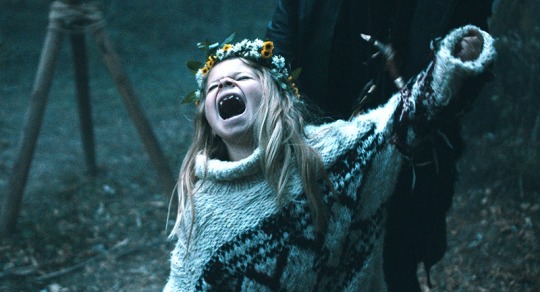
Gebbe won Best Director in the main competition at Fantastic Fest, and it would have been a crime if this were otherwise. Her control over what are essentially forces of nature is humbling. Extracting a profoundly moving drama from a cast of adult actors is challenging enough on its own, but to get these terrifyingly convincing performances from children, evoking deep trauma and physical violence to self and others, is another level. As if this weren't enough, Gebbe adds animals into the mix, giving the story of Raya a parallel in the troubled career of a police horse who is considered a lost cause by all but Wiebke. The training scenes in which Wiebke guides the volatile animal through fire and smoke, while her own lifeforce is being progressively depleted by her new child, are as harrowing as anything having to do with parenthood, and Wiebke seems to take the horse just as seriously as her child. Friendly single dad Benedikt (Murathan Muslu) tries to flirt with the trainer by remarking on her unusual career, but she spits bitterly, "The horses are not the problem," giving us a glimpse of the philosophy that drives her.
Another of my favorite german films is Werner Herzog's 1976 short NO ONE WILL PLAY WITH ME. This funny and poignant story involves a bullied and neglected little boy, and it is preceded by a card displaying the adage "There are no bad children, only bad parents." This is the principle that drives Wiebke in work and life: Those who are seen as failures, have been failed by others. One has the sense that Wiebke sees herself in these wretches. She has no partner, and balks at questions about her relationship history, shying from physical affection even with people she knows and likes. A tell-tale scar graces one cheekbone; when she finally begins to welcome the benign Benedikt's advances, he strokes it instead of kissing her, acknowledging that he can see who she really is.
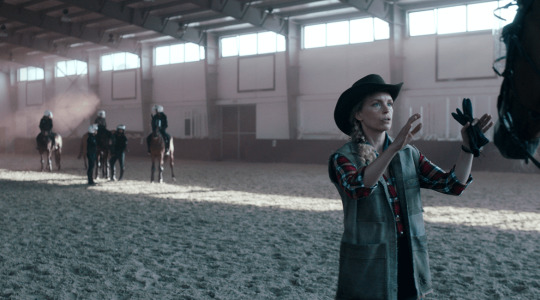
Wiebke tries to extend this same empathy toward Raya, refusing to let the child bait her into wrath and rejection. However, this show of pure faith and tolerance does not work, and the right approach becomes less clear as Raya begins to blame her mounting acts of vandalism, arson and assault on an evil entity that controls her will. A psychiatrist aprises Wiebke that this is the "magic period", in which the child uses magical thinking to divert feelings of guilt and responsibility. But, after a fashion, Wiebke begins to sense this malevolent presence as well. Is this etheric intrusion real? Or is she beginning to empathize with the child--with the experience of grappling with a damaged part of yourself--to the point of dissolving boundaries?
The title of the movie refers to a fable about a pelican whose chicks die, and she resurrects them by feeding them her own blood. This is a clear metaphor for Wiebke's trial with Raya, that becomes shockingly literal when, after endangering her home and relationships by prioritizing the new child, Wiebke places her own health on the line by taking an unregulated drug to give herself a bizarre advantage. When Wiebke discovers the shocking nature of Raya's original trauma, she experiments with the radical idea of treating the girl like a little baby, hoping to start from square one with her capacity to be mothered, and in the service of this dreadful proposition, Wiebke starts taking a lactation-inducing pill that proves to be an immediate risk to her health, and puts her in an even more perilous position with Raya.
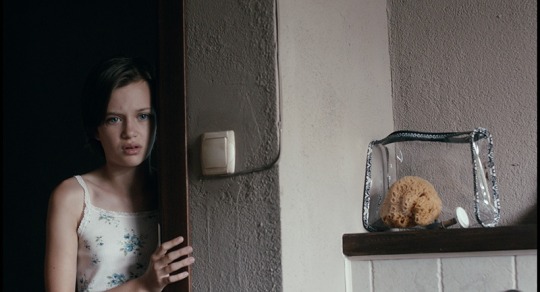
Although it focuses on a preternaturally devoted mother, PELICAN BLOOD recalls what makes movies like HEREDITARY and WE NEED TO TALK ABOUT KEVIN so potent. We have the idea that in becoming parents, we are perpetuating our own essence, extending our history and celebrating the precious connection of blood, which is supposed to impart an automatic same-ness. Unfortunately, this only shakes out to arrogance for many, denying the quirks of psychology, chemistry, and the unique impact of trauma--even if minor, or explainable as something benign--on a mind too young to fully comprehend the nature of the experience. Even without abuse in the home, anyone can have a child less like themselves than they could have ever imagined, for reasons beyond their own control. In all this, the child is innocent, and it is the duty of the parent to prioritize the child's feelings, over the vanity of wanting an heir to your own best qualities. Wiebke sacrifices not only her vanity, but potentially her very life, to show Raya love. When this blood sacrifice does not work, Wiebke finds herself facing the realm of alternative belief as a last resort.
The introduction of PELICAN BLOOD's folk horror element can seem a little left field, if you haven't noted the clues scattered throughout the film. Before the revelation of Raya's boogeyman, Wiebke begins to discover evidence of an old pagan tradition still being practiced around her proverbial neck of the woods. Soon, she tentatively entrusts herself and her child to a local witch, who puts them through a harrowing exorcism. Though the process is uncertain at first, its impact forces Wiebke into a direct acknowledgment of the entity harassing her daughter. And ultimately, it awakens in Raya a capacity for love.

While the reality of the supernatural in PELICAN BLOOD remains in question, I think the effect of this ambiguity is specifically meaningful. I usually scoff at any type of "was it all a dream?" nonsense, as this is a tactic employed by directors who think their greatest accomplishment should be getting one over on the audience. I don't see any inherent value in simply reversing the apparent meaning of things, just to make people feel stupid--and worse, this has trained modern audiences to try to defensively predict the least likely ending to any story, instead of just engaging with it emotionally as it plays out. For this reality-bending trick to be worth anything, one must be able to answer questions like, IF this was all a dream, THEN what meaning is added to the story?
In PELICAN BLOOD, the unresolved question of whether magic is real is of great relevance to the whole concept of belief. Human beings crave extranormal experience; we're deeply attracted to tales of ghosts, UFOs, mythical creatures, and parapsychological abilities. Even the skeptics among us enjoy arguing about these things, and many regular folks without eccentric interests read their horoscope "just for fun". Most telling of all is the enduring popularity of stories about the strange and unusual, which require no particular belief system from the audience; the fantasy of this extra dimension to our mundane lives is just so satisfying. Despite all the pleasure we get from these ideas, though, we tend to cling first and foremost to objective truth; we tell ourselves that if there is no "proof", then an outrageous thing cannot exist. But, this is actually contrary to many of our lived experiences. On the basest level, we delight at videos of insane parkour stunts, at the same time that we say these guys are "like" superheroes, but are actually just guys. My question is, what's the difference? If a person can achieve physical feats that most of us can never imagine attempting, then what difference does it make that this person was not bitten by a radioactive spider? If a fortune teller in a carnival is so good at "cold reading" strangers that she gives the effect of being able to read minds, then what is the appreciable difference between a carny and a "real psychic"? If a faith healer "just convinces" someone to become free from a chronic ailment, and the patient goes on to live a happier life, who cares if no "real magic" was in evidence? What is the difference between exorcism and hypnosis, if the end result is the same for a seriously disturbed child and her mother? The only difference appears to be some material confirmation of specific mystical forces and substances--which, admittedly, would be exciting on its own--but this would still only be an alternative version of the events that led up to the same "miraculous" result. We only worry about the existence of God and magic because our definitions of these things tend to be limited to what we think of as literal and scientific. But, if the correct effects manifest themselves, then all that is purely cosmetic. Belief is real. Faith works.
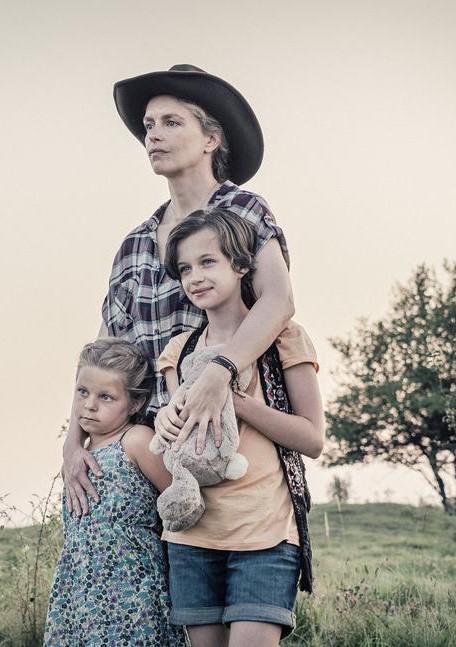
#blogtober#2020#pelican blood#pelican blood 2020#katrin gebbe#nina hoss#Adelia-Constance Giovanni Ocleppo#Murathan Muslu#Katerina Lipovska#drama#folk horror#witch#witchcraft#exorcism#possession
9 notes
·
View notes
Text
Me Going Through Star Vs Tv Tropes
So while Tv tropes is a fan thing similar to the Star vs Wiki and is imperfect in many ways. i was curious to check it out and see what had been put there for some aspects i was interested in in terms of the show.
And boy, is it interesting.
I checked out cleaved first because i heard so much about how this page was outright going on about how much the finale messed up, and they weren’t wrong, it actually feels like whoever wrote this was pretty mad themselves.

There’s discussion about the implied genocide, the implied dangers of merging worlds, heck, this entire page went over obvious plot holes.

It is the most salty thing i have seen in awhile, and it’s kinda funny in a way, this one got to me man:
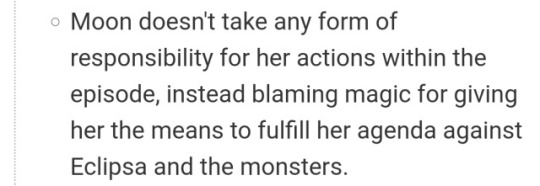
it hits on mos of the critisim towards the episode and some more that some people may of missed upon first glance, so for all it’s faults i give it credit for finding new ways of disscussing everything wrong with the finale in ways that make it easier to understand where things went wrong for others.

I will admit though, the page does try to jusitify star’s actions despite also pointing out how bad they are with the “Saving of the monsters”, and it feels like someone should add the fact that there were other solutions available as pointed out by previous episodes and star’s actions aren’t easily forgivable considering the damage her actions caused outweigh the good intentions.
I think people are happy she wanted to save the monsters and wouldn’t let them die but the magic destroying thing would have massive consequences and the ideas behind it are not fleshed out enough to justify this was the best course of action for mewni and it’s future.
The monsters are saved, but will the destruction of a vital source for the universe mean better for everyone across all dimensions, including the monsters?.
After i wanted to check out tom’s family junk, see what they had, and at least someone added the fact eclipsa’s family and tom’s family almost seem to be parallels because even though people picked up on it, and me myself wanted more done with that....clearly nothing came of it, so i’m glad they have a section on that.
though someone did forget to add wrathmelior having wings to her section.
Honestly this little tidbit stings considering the ending:
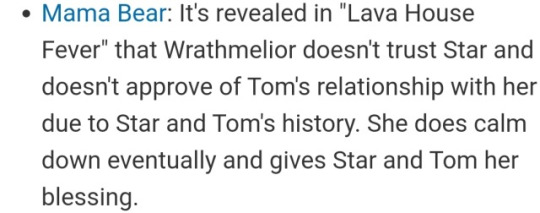
Honestly what they have for dave is the weirder section cause since his character got shoved to the wayside and little was done with him, most of his section is a lot more guesswork about his relation with tom then anything
Like some of the tropes with him and wrath are funny because well, they fall into some fun couple troupes, all his stuff with tom are more...like putting his original abusive persona mixed with what he’s like now:

Honestly in show where tom got his anger from relationship wise is not made clear since his parents were in 2 episodes.

like THIS was a detail that was a thing when tom’s dad was still an abusive demon, but i really don’t know how much this applies now. Dave seems to maybe have anger issues (I mean the dude threw a chair out of a window), but how tom feels about it or how big they are is put into question now.
Not to mention the “Big Guy” thing also seems like an abandoned part of OG dad and it feels like the show was going to make him a major character but abandoned it.

Like again, i wonder if these details should even be there because their canoncity is put into question since this stuff is coming from the original design of tom’s dad and not this current iteration. And i’m not sure if we have enough to even imply that dave is oblivious or has a serious temper since his anger has been shown once in the series.
i mean this is interesting cause i get to see what they put as far as minor characters and yeah it makes me wish the characters were used more because then the show could’ve done something with dave to actually give him a more clear character then having people base his personality and relationships off probably outdated info?
or at least, daron should’ve actively disbanded that info herself at one point or another if it’s untrue. It just feels like dave is supposed to be a wildly different character now but his og character is leaking in cause the show refused to give him anything to make people think of him differently.
tv tropes even mentions this was the original pitch, the abusive demon thing, so it’s weird they kept these elements while knowing they were adabonded

most of the rest of his page is pretty fine i was mostly curious about his page because i wanted to see how this thing would handle a minor character who was changed so drastically

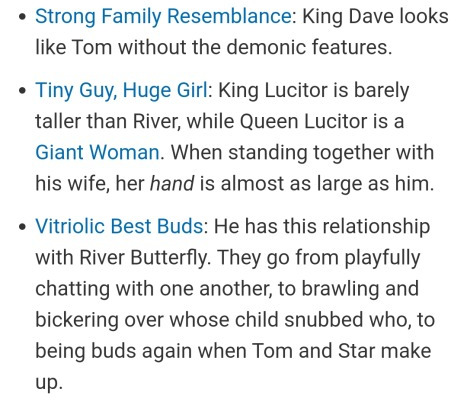
Moved on to tom’s section, it’s decent at showing his flaws but reminding the people reading of his arc and improvement.
I love at least it addresses a lot of stuff i’ve been saying for years though


as someone who is used to people downplaying tom as a character, it’s neat here they do indeed consider tom is basically be almost the 3rd most important character in later seasons.

though concept alone did not gather him such a prominent fanbase, tom was just a good and interesting character in general and even the crew knew it, which is why even after the show ended how it did so many fans still consider tom a bright spot in it.
Tom still has a bunch of haters who refuse to like him no matter what and will probably never like him no matter what.
But most can agree he had a proper arc and his character remained likable and enjoyable at a time where a lot of characters were becoming increasingly hard to watch.
Tom didn’t just have a cool design, he was just a good character, and he and eclipsa have similar reasons for still being beloved even despite everything, the show never really ruined them for anyone, if anything, people cared about them WAY more then most of the other characters because they never got butchered like moon, star, or marco felt like they did.
Then i moved on to stuff about after the finale, and yes, the page remains salty.
I mean, i knew the show was being screwed bit by bit because as a fan i was keeping a close eye on this stuff, commercials, time, dates, ect. It hurts to see it though cause at the time people thought moving to Disney channel was gonna mean GOOD things for the series.
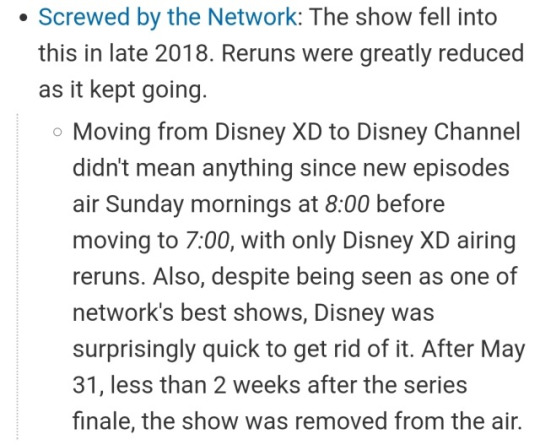
which sucks because THIS was also very true:

they did so much on their twitter to boost star, heck, it was designed to look like star, they showed star fanart, had star livestreams. Like Disney used to push this show hard till it slowly seemed to stop caring.
The Ama is also addressed briefly, especially Daron’s reaction, and yeah....
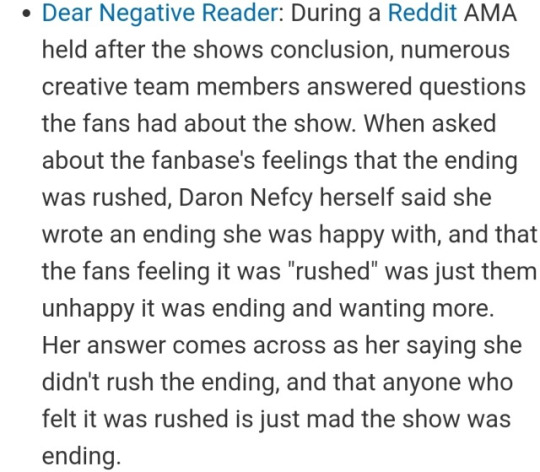
Still makes me pretty mad tbh.
Here’s some interesting stuff i found as well

From Friend-enemies

apparently this was gonna be a thing.

Also from tom’s section, which makes me wish we got stomco instead of what we got cause it’s so clear that finale had those implications and sad to see where it ended up.
Oh, and my favorite one:
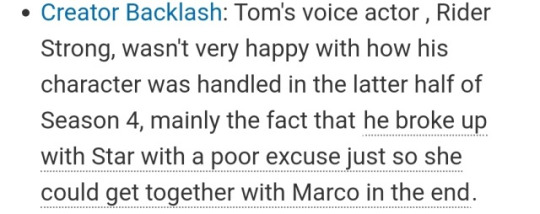
Me too Rider, me too.
I hope someday you get better treatment for your character, especially since it was clear you loved playing him so much, i would’ve been mad too.
Yeah, so i checked out Tv Tropes under star to look at some things, it’s not perfect but kinda interesting, and hopefully i find time to go into stuff like this more in the future on this blog.

#star vs the forces of evil#svstfoe#svtfoe#Tom the Demon#tom lucitor#marco#marco diaz#star butterfly#Dave Lucitor#king lucitor#queen lucitor#moon mention#wrathmelior lucitor#analysis
41 notes
·
View notes
Text
Many of the side character’s stories and development in Trials of Apollo mirror and support Apollo’s own development
One of the things I love about ToA is how many of the other characters’ stories, their situations, their development, mirrors and compliments Apollo’s own development, reinforcing the story of how Apollo changes from being a selfish, arrogant, shallow, apathetic person, to one of the most selfless, humble, aware, and empathetic people in the Riordanverse.
Meg Mccaffrey
Obviously Meg’s story is the one that mirrors Apollo’s the most. I’ve already talked about this in past analyses however, and it’s so blatantly obvious I don’t want to waste time making a point that I’m sure all my readers already know. Maybe I’ll make another analysis focusing on Meg later, but I’ll skip over her for now.
Calypso
Fairly superficial similarities here. Calypso is also a former immortal who’s learning to deal with the loss of her powers (though not TOTAL loss) and being thrown into the demigod world headfirst. The emotional core of their experiences is different though, since Calypso’s whole thing was that she was trapped on an island (albeit a nice one) under house arrest for thousands of years. Apollo wasn’t really trapped like that. Even saying he was METAPHORICALLY trapped is a bit of a stretch, Zeus doesn’t seem to have been to involved in the day-to-day business of what Apollo got up to.
Lityerses
This one IS fairly similar actually. Lityerses is controlled and manipulated by his father, and it sounds like he’s okay with that - like he’s as bloodthirsty as his father is.
“Right.” He regarded Calypso. “I think I’ll keep you alive long enough to kill you in front of Valdez’s face. That’ll be fun. But this former god here...” Lit shrugged. “I’ll just have to tell the emperor that he resisted arrest.” (TDP 152)
But there are hints that maybe there’s more going on there. His muttering of “I hate that” when Midas casually mentions accidentally turning Lit to gold in The Lost Hero, him being glad that Apollo gave his father donkey ears, his casual mistreatment by Commodus - all of it gives the clues that maybe there’s a REASON for his attitude, for his behavior.
What it does NOT do, however, is hint that Lit could be a better person. None of any of the heroes’ encounters with Lit actually suggests that. That’s a leap of faith that Apollo makes, hoping that MAYBE, just maybe, Lit will be a better person if someone gives him a chance. If someone shows him kindness, helps him when they have no good reason too. He identifies with Lit. The hidden depths that Apollo’s shown as a mortal... they wouldn’t be apparent to a casual observer of him as a god. Heck, APOLLO didn’t know they were there! He’s constantly surprised at himself, at the kind of person he is now, at the sort of things he’ll do. Apollo gives Lit the chance he wants people to give himself, the sort of chance that he didn’t even really realize he needed. Showing him - showing Apollo - showing Lit - that level of kindness, mercy, and concern, when there’s no ulterior motive, showing it just because this is another person, and they haven’t really done anything to ‘earn’ compassion beyond that simple fact - that threw both of them for a loop.
In Apollo’s case, he really started appreciating others compassion in THO, when his children took him in, treated him as family, cared for him, said they’d protect him against anyone who gave him trouble.
“If anyone gives you trouble, Kayla will shoot them. Then I’ll curse them so bad they’ll be speaking rhyming couplets for weeks.”
My eyes watered. Not so long ago - like this morning, for instance - the idea of these young demigods being able to help me would have been ridiculous. Now their kindness moved me more than a hundred sacrificial bulls. I couldn’t recall the last time someone had cared about me enough to curse my enemies with rhyming couplets.
“Thank you.” I managed. I could not add “my children”. These demigods were my protectors and my family, but for the present I could not think of myself as their father. A father should do more - a father should give more to his children than he takes. I have to admit this was a novel idea for me. It made me feel even worse than before. (115)
It makes a difference here that his kids are helping him when he couldn’t offer anything back. If he’d still been a god, he wouldn’t have given their help much thought. He would’ve just thought that he was entitled to it, and that it’s not like he’d REALLY need them anyway. But this? This is different. They’re helping him just because they care - it’s not anything transactional. Apollo isn’t used to thinking about relationships this way - not for the most part anyway. His relationships with Artemis and Leto are solid, and he seems to have genuinely cared for Hyacinthus, genuinely loved him as a person, and cared for Asclepius quite a bit, but aside from that? Not so much. Certainly not caring about someone who’s practically a stranger.
This set an example for Apollo, one that he carries forwards to Lit. Lit also has never been shown this sort of kindness before, kindness when he’s at his most vulnerable, compassion without an expectation of a return, and most especially, compassion when he’s given Apollo and the Waystation residents every reason to reject him. And that compassion is enough to cause him to break down, to rethink his whole stance on life. Seemingly overnight, he changes from being the brutal, cruel killer who would murder Calypso in front of Leo just to hurt him that much more, to being a lost person just looking for something or someone to live for, to fight for. And having found it, he suddenly softens, becoming kinder, more balanced.
But it’s not really an overnight change, is it? This other side has always existed, it’s just been hidden under layers of bravado and cruelty. That’s why both Lit and Apollo are able to change their mindsets so quickly - not all the aspects of what they’ve learned is truly “new”, they just haven’t applied them like this before, or not for a long time. Apollo’s experienced these sorts of caring relationships with Leto and Artemis at least, so they’re not totally a foreign concept. I’m betting in Lit’s case that he and his sister, at least at one point in time, did truly care about each other. The difference is seeing it applied more broadly to themselves by people who don’t already know them well, and then applying it to others that same way in turn.
Piper
Piper’s whole identity crisis has similarities to Apollo’s own. She was thrown into a situation where people expected certain things of her, and she just kinda... conformed to them. Which isn’t to say that she might not have chosen them herself on her own, but she didn’t really get that choice. Now that she has the time and has had a chance to think, she’s trying to find herself, figure out who she is. Her dad being financially ruined throws a wrench into it, but both of them returning to their roots, her father seemingly having more time to spend with her - those aspects are familiar. Apollo’s now figuring out who he is, now that he doesn’t have “being a god” to define him, along with everything else associated with that. His having his godhood stolen, and only now spending time really getting to know his kids and his demigod half-siblings, along with many, many others, is like how Piper’s dad now has time to spend with her, time he didn’t have before - a silver lining in this whole mess.
Apollo’s advice to Piper seems to be talking about himself nearly as much as it’s talking about Piper.
“It’s been my observation,” I said, “that you humans are more than the sum of your history. You can choose how much of your ancestry to embrace. You can overcome the expectations of your family and your society. What you cannot do, and should never do, is try to be someone other than yourself - Piper McLean.” (265)
With how Apollo’s grown throughout the series and ESPECIALLY in TTT, this fits him as well. Apollo is more than the sum of his history, of what he has done, of what has been established by the older gods. He can choose how much of his past - and his family - to embrace, and overcome the expectations of his family, both godly and mortal, and of godly society. And he will do it by being himself, his WHOLE self, including the parts of his being that he’s been nurturing as a mortal, the compassionate, empathetic parts of himself.
Jason
Jason is a little different, because I don’t think his development, his situation parallels Apollo’s CURRENT situation, so much as Apollo’s future development. His willingness to sacrifice himself, to be the one who dies so that his friends can survive, wanting to keep secret about the prophecy so that Piper doesn’t try to stop him, so that hopefully he can keep her safe, even if it means merrily walking to his own death.... I’m expecting Apollo to get into a similar situation in TON. Though there are elements of that he’s already lived through, since he ALREADY chose Meg’s life over his own in TDP, and in TTT, he tried to conceal and downplay just how badly he was hurt to try to stop Meg from worrying as much.
Frank
Frank carries his mortality - the stick that’s attached to his life force - around with him. He’s decided that in order to lead the Legion effectively, he has to put one hundred percent of himself on the line. He can’t let fear hold him back.
Apollo’s mortality is also on the line all the time. Originally he wanted to hide away, to cower behind others so as not to die (not that he actually tended to go THROUGH with it, either because he couldn’t or he wasn’t willing to abandon them) but now? Now he doesn’t even try. He wants to live, that’s true. But he values his companion’s lives more. He won’t hesitate to put himself on the line, to commit himself completely if he believes that it gives them a greater chance of survival.
The greater parallel however comes later, with Apollo’s hypothesis for how Frank survived his stick burning up. He believes that maybe since Frank took charge of his own destiny by willingly sacrificing himself, that he was freed from his old destiny and forged a new one:
“It’s just a guess,” I admitted. “Frank went into that tunnel knowing he might die. He willingly sacrificed himself for a noble cause. In doing so, he broke free of his fate. By burning his own tinder, he kind of… I don’t know, started a new fire with it. He’s in charge of his own destiny now. Well, as much as any of us are. The only other explanation I can think of is that Juno somehow released him from the Fates’ decree.” (393)
I don’t know how plausible this explanation is. Honestly, it kinda sounds like BS to me, especially since Jason did the same thing and HE died. But what’s important here is what APOLLO thinks happened. His explanation says as much about him as it does about what he thinks happened with Frank.
Breaking free of your fate by accepting, by EMBRACING your own mortality, putting everything on the line, sacrificing yourself completely in order to have a shot of stopping your friends from being hurt or killed... it’s similar to what happened with Jason, but with the added twist that Frank survived and started a new story, free of his previous destiny.
The destiny thing is really important. As a god, Apollo’s not ‘supposed’ to be able to change or mature. The gods seem to believe that their nature is more set in stone than mortals are. But Apollo has disproven that. He’s changed a lot, and has continued to change. He’s forging his own destiny, one different than he ever imagined it could be. And maybe, just maybe, one that Zeus won’t have control over. One that’s truly his own.
Don the Faun
Don has only a small role, but what Apollo says about him - what he thinks about him - says a lot.
“Hey, Apollo, you- you know the difference between a faun and a satyr…?”
[…]
A moment later, his body collapsed with a noise like a relieved sigh, crumbling into fresh loam. In the spot where his heart had been, a tiny sapling emerged from the soil. I immediately recognized the shape of those miniature leaves. Not a hemlock. A laurel - the tree I had created from poor Daphne, and whose leaves I had decided to make into wreaths. The laurel, the tree of victory.
One of the dryads glanced at me. “Did you do that…?”
I shook my head. I swallowed the bitter taste from my mouth.
“The only difference between a satyr and a faun,” I said, “is what we see in them. And what they see in themselves. Plant this tree somewhere special.: I looked up at the dryads. “Tend it and make it grow healthy and tall. This was Don the faun, a hero.” (398-399)
Here, Apollo’s noting that the difference between satyrs and fauns are purely societal. That there’s no inherent difference between them. Like the difference between gods and mortals, mentally, isn’t that different. Gods may be more powerful, but they’re still people, like mortals are. The differences between them, psychologically, have more to do with how society sees them, and how they see themselves. Having had his godhood stripped away, this is very apparent to Apollo. Because he’s still himself. A better version of himself, in fact, but that has nothing to do with him being mortal - not in and of itself. But with the things he’s learned as a mortal. He can be a hero, truly. Because he is just as capable of such things as any mortal.
Reyna
And lastly, there’s Reyna. She too, like Frank and Don previously, broke free from expectations to forge her own path.
“My whole life, I’ve been living with other people’s expectations of what I’m supposed to be. Be this. Be that. You know?”
[…]
“But you showed me. When you proposed dating…” She took a deep breath, her body shaking with silent giggles. “Oh, gods. I saw how ridiculous I’d been. How ridiculous the whole situation was. That’s what healed my heart - being able to laugh at myself again, at my stupid ideas about destiny. That allowed me to break free - just like Frank broke free of his firewood. I don’t need another person to heal my heart. I don’t need a partner… at least, not until and unless I’m ready on my own terms. I don’t need to be force-shipped with anyone or wear anybody else’s label. For the first time in a long time, I feel like a weight has been lifted from my shoulders. So thank you.” (405-406)
Reyna thought that she was supposed to find a partner. Everyone else thought she needed a partner - needed romantic healing. Until Lester asked her out. Until she saw how ridiculous it was to let others expectations - or curses, or whatever you’d call Venus’s little prophecy - control her life.
Apollo has a similar thing going on with letting expectations about what he’s supposed to do, about who he’s supposed to be, control what he does - or did, at least. I’ve gone over that already, so I’ll skip past that.
But the romantic angle? About thinking - or having others think - that she needs to be healed romantically? That also falls in line with Apollo’s development. Apollo’s had a LOT of romantic relationships, and a decent number of them have ended in disaster. He seems to be convincing himself that some romance will “fix” things, like with how he convinced himself that getting together with the Cumaean Sibyl would fix things:
But that wasn’t enough for me. I was smitten. I convinced myself it was love - the one true romance that would wash away all my past missteps. I wanted the Sibyl to be my partner throughout eternity. As the afternoon went on, I coaxed and pleaded. (131)
But he wasn’t in love with her, not truly, or his love wouldn’t have turned to hate so fast when she refused him. He just really WANTED it to be a shining romance, one that would finally fix things.
He actually does seem to be finding this sort of fulfillment now, but not with romantic relationships - with more platonic, familial relationships instead, such as with Meg.
I’d always wondered what it would be like to have a younger sibling. Sometimes I’d treated Artemis as my baby sister, since I’d been born a few minutes earlier, but that had been mostly to annoy her. With Meg, I felt as if it was actually true. I had someone who depended on me, who needed me around no matter how much we irritated each other. I thought about Hazel and Frank and the washing away of curses. I supposed that kind of love could come from many different types of relationships. (192)
I don’t think he’s realized it yet, but in a way, Meg seems to be “washing away” his curse of loneliness, of feeling empty. Taking care of her, connecting with her, bantering with her - this is what he needed. To be a protector. To be a friend. Romance is fine, but they’re not the only fulfilling sorts of relationships.
Honestly with Reyna and Piper both taking a break from romance in order to find themselves, I think that Apollo may lay off the romance for a bit after ToA’s over, work on his more platonic relationships instead. I don’t think he’d swear it off, but maybe look for something more steady than he was before. And with the experiences he’s had as a mortal, I think he could better recognize truly serious love versus a temporary infatuation.
Final Thoughts
I really love how focused this series is on developing Apollo! A lot of aspects of this series seem geared to do that, from who the antagonists are and how they act, to the storylines of the side characters. It allows a level of development for Apollo that’s deeper and more nuanced than with any of Rick’s previous protagonists, even Percy. I look forward to seeing how Rick will conclude his development. If his writing for Apollo in TON is as solid as for previous entries, I’m sure it will be worth the wait.
#ttt spoilers#the tyrant's tomb#trials of apollo#toa spoilers#the trials of apollo#analysis#my post#apollo#lester papadopoulos
173 notes
·
View notes
Text
A Pre-Sequel? The Dark Crystal: Age of Resistance
So I’ve watched both the 1980s movie and Age of Resistance.
Maybe it’s because I saw the movie first and then the series, and I know fully aware that the series is supposed to be a prequel, but I purpose that the series is instead a pre-sequel.
So first, what is a pre- sequel?
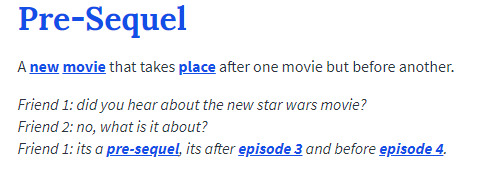
In laymans terms it’s a sequel that can tell a prequel story
Some examples:
Lion King one and a half
Boarderlands the Pre-Sequel
So in the case of The Dark Crystal, I’ve found evidence that can suggest that Age of Resistance can be a prequel while telling a sequel story that is after the movie.
Spoiler warnings are now ahead if you haven’t watched either...
Disclaimer, I know there are novels as well, but I am only going to focus on the relationship between the 1980s movie and the new series.
Case one, The Ending of The Movie and the Opening to the Series
In the 80s movie it is very much stated that the urRu and the skeksis were once one being but split. When the movie ends, they are joined back as one and the Crystal is restored. They leave the crystal in the care of the Gelflings.
In the intro to AoR it talks about the Gelflings came together to form the great clans and watched over the crystal. It was only until AFTER the Skeksis came that they then turned their loyalty towards them instead of the crystal.
Also in the intro, Mother Aughra has a new laboratory because in the movie her former lab was destroyed when the Skeksis were trying to hunt for Jen. So that only tells me that some time after the crystal was restored, either by the Gelfling or the Skeksis, someone helped her build a new laboratory before she went into that deep sleep into the stars.
So this, to me shows a sequence of events that can flow from the movie to the series instead of the other way around.
Case two, The Heretic & urGoh
In the later episodes of season one, we are introduce to a Skeksis named “The Heretic”, the reason he is dubbed so is because he sided with his urRu counter part. And he tells Rian, Brea, Deet and Hup about the concepts that were the main plot of the 80s movie.
He tells them that the Skeksis and urRu were once one being and talks about the prophecy.
So, here’s the question: How would the Heretic know about those things if this is supposed to took place before the movie?
If you’ve notice, none of the other Skeksis talk about that throughout season one. The only others who bring mention to it are: The Hunter, The Archer, and Mother Aughra.
Since we know Mother Aughra has been around for both instances as well, my mini theory is that when Skeksis and urRu were split again, some of them chose to reject their past and chose to revert back to their former lives as lords of the crystal. Thus when the Heretic didn’t, they expunged him from their ranks, thus earning his namesake. This is also a choice in that, when you compare, all the Skeksis kept their names. It wasn’t a case of- “oh they follow their predecessors likeness” no, they ALL know and they ALL remember what their past was like.
But unlike the Heretic, they chose to reject it.
So, when the Heretic saw the corruption spread, he took the necessary steps to try and “reenact” the prophecy from the movie, with Rian, Deet, and Brea. More specifically, when Brea discovers Lore at the bottom of the castle and they journey to the Circle of the Suns. (Of which I personally think is the ruins of the old castle from the movie, further proving that The Heretic remained and actively remembers what happened from the movie)
Case three, Maudra Argot the Shadow Bender
Ok ok hear me out on this. I know this character doesn’t have a big role to play but she is very interesting in the grand scheme of things.
First, let’s talk about her origins. She is the Maudra of the Grottan clan. They’re the cave dwellers and live among the wildlife of Thra. They are down to earth, humble, and care about Thra arguably the most out of all the clans. They care about the well being of the natural balance and they house one of the Sanctuary Trees.
If you’ve seen the movie as well, you’d know this fits like a glove with none other, than Kira.
So, I purpose that Kira is the founder or at least the ancestor to the Grottan Clan. Also, Argot does something that very well may link her lineage to Kira even more:
Argot can call a landstrider.
It may not seem like a big deal because Vapra domesticated them before. But the difference is that Argot can call a wild one on demand. And she says and I quote “I still remember some tricks from topside!” - Season one episode 9
This stuck out cause for the most part aside from Deet, none of the other Grottan venture to the surface. Argot has apparently.
Also in episode 9, she says that Rian’s father wielded the Dual Glaive and trusted her with half of it after the Arathim Wars.
So this lets us know that:
The Gelfling have been around long enough to wage wars against the Arathim.
The Dual Glaive and the fact a Gelfling is always the one wielding has been a constant in both the series and the movie.
The Heretic must have known that the cycle of the Skeksis lust for power was doomed to repeat itself so he made PREVENTATIVE measures for such an occasion.
Also to throw into the whole Argot mix, look at her full name “The Shadow Bender”.
Now you don’t just give out badass names like that on a whim. She knows far more than what’s been lead on, and possibly did a lot in her prime. Gelfling life expectancy isn’t really expressed in the movie or the series, but if there’s any connection between Kira and Argot, I’d say she could be a very great grand-daughter of some kind.
The parallels seem too coincidental imo.
Counter arguments
As I said, I know the initial intention for AoR is to be a prequel
Dreamfasting being this new concept in the movie between Jen and Kira
Jen and Kira surviving the downfall of their clans
The Scientist creating the Garthim
I get it, don’t worry...
However that doesn’t mean it could also hold some sequel elements while still telling a prequel story. It has been done before in the case of The Godfather Part 2:

Also I want to point out, this is a series that’s driven by the cycle momentum.
Meaning that after X amount of time the cycle repeats itself. Same concept different characters.
You’ve seen this with other series like:
Dark Souls
Avatar the Last Airbender
And many other shows were it involves certain events repeating themselves. Who’s to say that the cycle in the 80s movie is a precursor to the cycle in the series? Maybe it’s vice-versa!
All in all, this is just my thoughts and theories on the relationship between the two.
If you made it this far, thanks for taking some time out to read it I know it’s a lot!
And please, no rude comments thanks!
#Meta talk#Dark Crystal Theory#The Dark Crystal#Dark Crystal Age of Resistance#Long post#Spoiler warnings#Spoilers#Long post tw
9 notes
·
View notes
Text
A Buffy rewatch 5x19 Tough Love
aka you are not immune to… internalized bi erasure?
Welcome to this dailyish (weekly? bi-weekly?) text post series where I will rewatch an episode of Buffy and go on an impromptu rant about it for an hour. Is it about one hyperspecific thing or twenty observations? 10 or 3k words? You don’t know! I don’t know!!! In this house we don’t know things.
And in today’s episode Tara’s not perfect and gets her mind sucked out for it, we kick off the season’s multi-episode finale arc by revealing Dawn to Glory, and we draw some weird parallels between two of our dynamics. Perhaps mostly though, I’ll just talk about Willow’s sexuality, because at some point, we need to properly address that elephant in the room.
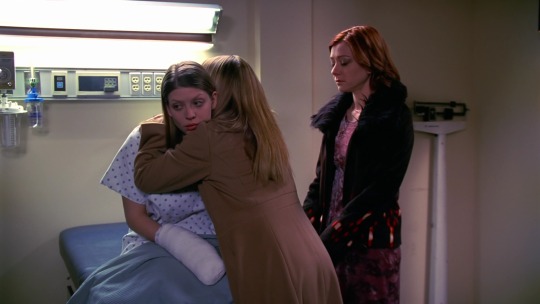
Okay, so, let’s just kick this off. If you’ve been in this fandom long enough, you’ve been inevitably exposed to the discourse of Willow’s sexuality. And you might be asking now… what’s the big deal anyway? Isn’t art up to interpretation? Wasn’t that one of my main motivations for this rewatch? Why does it matter that parts of the audience ascribe different labels to Willow?
And well… that’s valid, but it also misses a crucial element of our media, one that I alluded to in my rant about Whedon character deaths. Art doesn’t happen in a vacuum. And the significance of that is only amplified for folks and groups whose experiences aren’t recognized or seen by society in the first place.
To them it will matter whether or not someone recognizes a character by a certain label. Because a refusal to do so feels like an erasure of their own identities. That’s what makes this whole discussion complicated in the first place.
Now, am I the best person to do a deep dive on this? No. Especially not in one of these barely proof-read long rant posts. I’m sure you can find much better sources, so please do that. But it’d feel disingenuous to ignore it too, so I’m just gonna address it to the best of my abilities as well as provide my own in-universe interpretation of what it could mean for the characters.
Great. Now for that pesky discourse.
Personally my go-to analogy to describe it is the classic Shrek onion one.
You see, you peel away a layer of the Willow’s sexuality onion… and it’s still an onion. You peel away all the layers, you chop it up, and sure, it remains an onion, but now everything’s a mess and you’re crying.
The issue is that you kind of need to peel those layers away anyway if you want to truly divorce yourself from the binary thinking that the show itself often engages with. Which is what’s arguably gotten us into this mess in the first place.
Because however you view Willow’s sexuality, you can’t deny that the show is doing a lousy job defining it. Willow does identify as gay/lesbian as of 5x11 and through the end of the series, but the language the show uses makes it impossible to just leave it at that.
In Doppelgangland, when Willow meets her vampire self, she describes her as “kinda gay”. Not gay, but kinda gay. We also see Vampire!Willow making out with Vampire!Xander in The Wish beforehand, so if Vamp!Willow is supposed to tell us something about Willow’s own sexuality, then it’d stand to reason that she’s bi. Right?
Well, apparently not. But then we run into her actual line in 5x11 where she first uses a label, saying “Hello, gay now!”. Notice, it’s gay now. As in Willow just woke up one day and turned gay. The same joke(?) is repeated in Intervention, where one of the characteristics that was programmed into Buffybot about Willow was saying Gay(1999 - ).
Now, that’s not to say that Willow can’t just have a fluid sexuality and identify anyway she fucking wants to, and she doesn’t need to justify her label to anyone. She fell in love with Tara, and that made her reconsider her own identity. Season 7 almost ends up addressing this too in a scene I think, so that’ll be nice to get to.
The issue mostly comes from the show skipping to engage even with the possibility that Willow (or anyone for that matter) might be attracted to more than one gender at the same time. The closest we get to this is with the love triangle setup in New Moon Rising, except I guess in this love triangle Willow also chose a sexual orientation?
It’s like that episode was the quantum superposition of Willow’s Schrödinger’s sexuality, and upon observation, it locked into either one of its two states. That’s why Tara’s been talking about getting a cat in that episode! Guys, we solved it!
Notice also that I’ve yet to really talk about Willow’s sexual history before Tara in regards to this… because for me that’s sort of less part of the point? If Willow was a real person, and you knew that she had this adorable boyfriend before she identified as a lesbian, you wouldn’t go up to her and question how she defines her own sexuality. I mean… I hope so? Don’t be a fucking asshole.
But that’s both the fallacy of the argument and the reason why you should still respect the label Willow identifies with. Because Willow is not real, she’s a fictional character, and therefore arguments can and should be made about how the show portrays her sexuality… And yet, the people who identify with Willow are very much real, and so are their own experiences of people dismissing their own chosen identities.
So, there you go folks. These are my two cents. Willow’s gay, but we need to acknowledge how the show appears to be either completely unaware, or actively dismissive of the existence of bisexuality. This even comes up in the S8 comics, where Buffy’s sexuality after having a relationship with a woman is continuously referred to as essentially “not-gay”. Because I guess in the Buffyverse canon these are your only two options.
Now that we got all that out of the way, we can briefly talk about this episode, I guess.
To keep it on track, I guess we should dissect the argument between Willow and Tara that sort of caused me to whip this whole discussion out here.
Now, this is a fascinating scene, because it pivots a lot, and reveals a lot about the characters and their insecurities. It also appears to be fueled by Willow’s own lack of self-reflection and Tara’s non-confrontational nature.
It starts with Willow complaining to Tara about how Buffy appears to be trying to be more strict with Dawn. Willow is obviously identifying with Dawn in the situation. But Tara says she completely understands Buffy.
This then probably reminds Willow of Buffy earlier telling her that she wouldn’t understand when she was talking to her about Dawn, which causes a mood shift in Willow. It also reminded me of season 3 of Buffy telling Willow the same thing regarding her connection with Faith, so as a Buffy/Tara shipper that association kind of delights me, ngl.
But as Tara pushes further, seeing that something is bothering Willow, she reveals the insecurity behind it. Willow isn’t just responding to Tara having this wisdom through this major, tragic life experience that she can relate to Buffy with; it’s that Tara’s done all of this so much longer than she has. She’s been a witch all her life. She’s been out much longer.
That however then triggers Tara’s own insecurities about Willow rapidly surpassing her in her own magical abilities, and says that that “frightens” her. She tries walking back on her choice of word later, but it’s too late, and Willow locks into that.
Now, this is some riveting stuff. Because with foreknowledge, the easiest interpretation here is that this will relate back to Willow’s abuse of magic in season 6. That deep down Tara already sees what having this much power will do to her girlfriend.
This is arguably even reinforced in the episode with Willow going after Glory. It’s once again foreshadowing, Willow attempting to take revenge for something that’s been done to Tara; but it also betrays a certain arrogance in Willow. She actually believes that she can take on Glory, a supposed God. (Which, honestly? She probably could by season 7.) That’s the kind of power that she wields and how she chooses to use it.
Still, in the argument itself Tara pushes this fear of hers in a slightly different direction, saying that she’s afraid that she wouldn’t be able to fit into Willow’s life, after all these changes. And that’s where the previous discussion fits in.
Perhaps to understand Willow’s response, we should remember how magic has been used as our lesbian metaphor for almost a whole season. Because she almost immediately jumps to the conclusion, that Tara’s afraid that she would… go back to boys? Which is of course a classic, toxic stereotype used against bisexuals, despite the fact that no one here canonically identifies as bi, so add that to the discourse.
More importantly, it’s said by Willow. Now, Tara totally drops the ball here, asking her “Should I be?”, which reinforces the validity of Willow’s assumption that it’s actually something that Tara is thinking. Even someone as perfect and precious as Tara is not immune to propaganda.
In Tara’s defense, she once again tries dancing back on it, and talking it out before Willow storms out, but yeah. While I’d like to think that Tara’s question came more from a place of general insecurity, regardless of the gender of Willow’s next possible love interest, she sure fucked up in that moment.
Still, the fact that it’s Willow jumping to this debate, might just tell us more about Willow herself and how she sees herself.
Let’s go back to Restless for a bit. In that episode, Willow’s fear was ended up being about how she was scared that deep down she was still the same girl that she was in high school. That all these things she developed through college that made her stand out were just a facade, and that she was merely hiding her true identity as the same lonely loser she believed herself to have been back then.
So… and bear with me here… if we take that fear as a core motivation for Willow’s character, we can interpret the way she identifies her sexuality as a means to distance herself from her old identity. From this perspective, it’d perhaps even make sense for her to feel insecure about a supposed attraction to men, because she sees that as a regression to her old identity.
I can not stress it enough that this is merely a possible interpretation though. And one that would really only become satisfying if season 7 - which was already largely about reconciling with these different aspects of her identity for Willow aside the obvious theme of power - ended up tying it all together with Willow re-defining her own sexuality. It didn’t though, so I’m still left with the same conclusions, and this thought experiment of a character analysis.
Anywho, this is getting so very long, and there are still a few things that I wanted to touch upon this episode. Mainly the parallel we’re drawing between Willow / Tara and Buffy & Dawn throughout.
Normally, I love a good parallel storytelling. It’s efficient and makes the whole thing more cohesive. Here however, they manage to drive the parallel home so hard, that it just becomes weird at some point.
Like the fact that we have these two conflicts in the two relationships, arguably anchoring the episode? That’s good stuff. I also like the fact that Willow and Tara’s argument grows out of their discussion about Buffy and Dawn’s situation.
There’s actually a lot of great interaction in the entire episode. I love Dawn opening up to Spike about how she feels responsible for what would happen to Tara, and how she feels like she can’t be good because of all the terrible things happening around her. That’s a brilliant scene. Spike’s “Well, I’m not good and I’m okay”? I actually love him in that moment, not even gonna lie.
Buffy thinking that she actually convinced Willow to not go after Glory reminded me of a scene in Angel the series, where the gang thinks they managed to curve Fred’s impulses to axe murder her old professor. Do you all even know these people you call friends??? But again, I liked that exchange.
And okay, Buffy needed to be reminded what she would do if something happened to Dawn to realize what Willow was planning. Fine.
But then you’ve got the doctor asking Willow if Tara was her “sister” (to which she of course replied “She’s my everything”, and it’s fine, I’m fine), and then in the last scene, Buffy explicitly equating Willow’s need to take care of Tara with her own feelings regarding Dawn.
Again, I understand parallel storytelling. I love it. But when you’re equating a romantic and a familial relationship there’s a point where it becomes weird, and for me, these two moments put it just over that edge. This is of course a deeply subjective perspective, and I recognize that.
And then you also get Buffy trying to take on these new adult responsibilities in the episode. She’s dropping out of college to try and care for Dawn, and is faced with the challenge to become a parental authority figure in her sister’s life. The scene where she explains to Dawn that the reason she’s being tough with her, is because otherwise she could be seen unfit to be her guardian just gutted me.
This episode is just way too much, guys. And we’re only just at the beginning of the big finish of this season.
10 notes
·
View notes
Photo
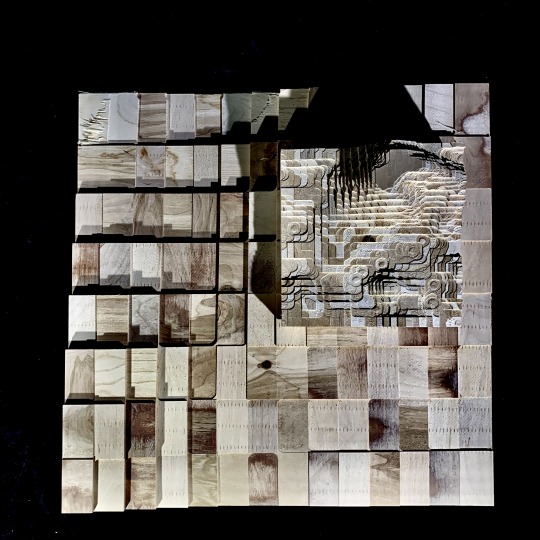


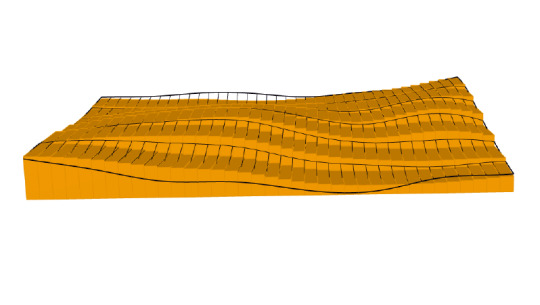






exercise 5. part 1 - surface to solid
In this exercise, topographical data points were downloaded from the NASA Shuttle Radar Topography Mission (SRTM) database and translated into a digital surface. Then, this surface was put into a grasshopper definition which extruded the surface from a given plane in order to generate a solid. This solid was milled on the CNC router through a materially reductive method, in which an instruction set consisting of coordinates (generated through RhinoCAM) informed the mill’s path to cut away material from the solid block of 20″x 20″x 3″ laminated wood. This study prompts attentiveness toward the implications of relative scale throughout all stages of design and fabrication processes, both how scale functions as a generator of unknown variability and as design tool.
selection of topography - scale of earth v. scale of the product, earth’s surface is actually very flat relative to size of sphere on which it sits. This flatness reads even at the scale of a single latitude-longitude swatch of extracted data points (NASA Shuttle Radar Topography Mission). In order to combat this scale and define an area in the lat-long that had appropriately variable elevation, the area extracted for the surface had to be reduced to 1:100 of the original area.
adjustment of parameters of gh determined solid - once the data points had been translated into a surface using the first grasshopper (gh) definition, the baked surface that came as a result was input into the new “chunky surface” definition in order to generate the solid. At this point, various adjustments to parameters within the gh definition such as min/max count, aspect ratio, or even a surface rebuild (not within the gh definition, but rather command within rhino onto the surface) all yielded variable conditions of the base unit, or the smallest flat element within the larger topography. Object 1 has many large, rectangular units as a result of a long series of arbitrary aesthetic adjustments, which equates to lower fidelity to the variability within the original surface and a more abstracted reading. Object 2 was not subjected to any parameter changes, and therefore exhibited much smaller and more square elementary units that were able to accommodate the true topography more accurately.
translation render-to-mill - in this final step, the implications of tool capabilities and limitations were made very apparent. On object 1, the size of the milled object, though it looks much less complex and of lower variability than object 2, took much longer to mill (3 hours opposed to 30 min) due to the fact that it was 2.5x the length and width of object 2. This is of practical consideration when constructing multi-step and piece models in which material efficiency/cost and time/labor costs are of relevance. In fact, it was due to time/labor constraints that the decision was made to mill object 2 at the smaller size. This resulted in some movement of the block during the milling process, as the shear forces were strong enough to begin to dislodge the form from its constraints (small blocks visible in fig. 8). Additionally, for object 1, the angle of approach of the end mill was set to 45 degrees for the finishing portion of the job (versus 30 degrees for object 2). This angle, accompanied by the low relative depth of each unit to those surrounding compared to its surface area might have been the cause for some of the shearing forces that delaminated some of the object’s top layers (visible in fig. 9, large flat space in bottom right corner of object 1). On the other hand, the large elementary units paired well with the .5 inch end-mill, in that the corner moments, though still rounded in actuality, look very angular at the scale of the unit whole. In contrast, on object 2, due to the fact that the elementary unit was about .5″x.5″, the reading of this corner bevel resulted in a much more jagged and organic looking finish. The scalloping and sometimes fully circular moments on the final product inadvertently begin to allude to the mountainous nature from which this solid was derived, all due to a matter of relative scales.
The milled objects hold some connection to the following systems example in Deplazes: Shin Takasuga’s Railway Sleeper House. “The universal utilisation of one single type of construction element for the whole structure – walls, floors, columns, roof structure, the built-in furniture too” (106) of the house allows it to read as a sort of natural extension of the forested topography of Miyake island, on which it is situated. Further blurring lines between landscape and building, “in the Railway SleeperHouse we can identify a subtractive design principle: the rooms seem to have been hacked out of a closed, cruciform stack with a rigid outer shape”. Similarly, the raw materials rely on the subtractive quality of the milling process to reveal the varied 'stacked’ surface conditions. One might even begin to reimagine the above exercise objects to some human scale, as containing qualities among its ridges and folds, where ridges begin to read as semi-hollow surfaces and platforms with habitable internal structure.
Source for Discussion:
Andrea Deplazes (ed.) “Materials - Modules: Timber, The Threads of the Net” in Constructing Architecture: Materials, Processes, Structures: A Handbook. Berlin: Birkhauser, 2005. pp. 106 -112.
3 notes
·
View notes
Text
Sixty fun & fascinating facts about the classic Supergirl (4 / 4)

At last, the final fifteen fun facts in a series to mark the sixtieth anniversary of Kara Zor-El’s debut in DC Comics. This is the last batch of Supergirl info-nuggets, bringing the trivia total up to sixty, one for each year since her introduction.
As before, each snippet of data relates to the original Supergirl, the intrepid Argo City teen who leapt from that crumpled Midvale rocket ship. Covering her original Silver and Bronze Age incarnation, in comics and on screen, each factoid is calculated to intrigue and delight – hopefully even seasoned Kara fans will find a few morsels of trivia that had previously escaped their attention.
So, one last time: enjoy…

46. At one point she was blacklisted from being mentioned in DC publications.
In 1985 to mark its 50th comicbook publishing anniversary DC Comics launched a mini-series, Crisis on Infinite Earths, that sought to rejig its entire fictional universe to better address the new, more mature, direct sales audience. Childish elements were removed and iconic characters rebooted. Superman was to be recast as the only survivor of Krypton, meaning Supergirl not only had to die but be erased from all past events too. DC, however, decided that erasing Kara from fictional history was simple not cruel enough -- in a move straight out of a George Orwell novel DC airbrushed her from in-real-life history too.
Supergirl became she who shall not be named, seemingly banned from being mentioned, even in the editorial pages. When DC couldn’t avoid using her name, as happened in Secret Origins #42 (July 1989) when discussing Phantom Girl’s first appearance, they masked it with asterisks like an expletive -- ”S*P*RG*RL”. DC even went as far as to exclude Kara from a bio of writer Paul Kupperberg in the pages of Power Girl #2 (July 1988), despite Kupperberg‘s long tenure as Supergirl’s chief writer, and Power Girl being a parallel-universe re-imagining of Kara. Yet the Maid of Might remained popular with at least some DC staffers, as Alan Brennert proved when Kara made a highly unauthorised crafty cameo in his Deadman story inside Christmas with the Super-Heroes #2 (1989) -- Brennert only avoided censorship thanks to DC editor-in-chief Dick Giordano volunteering himself to do the story’s artwork.
47. Prior to her role as Supergirl, Helen Slater had struggled with eating disorders.
In an obscure 1988 interview for UK tv with psychologist Oliver James, Helen Slater talked frankly about how winning the role of Supergirl helped in her ongoing battle with Anorexia and Bulimia. Asked about the cause of the conditions, “Control was one part of it”, Slater admitted, adding, “I think Bulimia especially, which I did suffer from from 13 [...] is a lot to do with not having a safe space to express anger.” She went on to credit her Supergirl fitness trainer, Alf Joint (“the most beautiful man in the world”) with overcoming some of her fears around food by using Chocolate Brazils (chocolate dipped nuts) as positive reinforcement after a hard training session.
48. She celebrated her 75th birthday in 2018.
It is generally accepted that Kara Zor-El’s birthday, when using the Gregorian calendar on Earth, is 22nd September. That date comes from a reply to a reader’s letter published in Adventure Comics #389 (Feb 1970), but said reply didn’t give the year of Kara’s birth, meaning readers couldn’t work out Kara’s age. (“One should never trust a woman who tells one her real age”, wrote Oscar Wilde, ”A woman who would do that would tell anything.”) Fortunately a little bit of detective work means that fans can work it out. A story in Action Comics #305 (Oct 1963) gives the date of Kara’s arrival on Earth as 18th May 1959, and both the Daring New Adventures of Supergirl #1 (Nov 1982) and Action Comics #270 (Nov 1960) suggest that Kara was 15 years old when she landed. This means that she was born in 1943. So, as of her most recent birthday at the time of writing (22nd September 2018), she would require 75 candles on her birthday cake. Good thing she has Kryptonian super-lungs..!

49. Her nickname was Hot Dog.
Every fan knows that Kara Zor-El is Supergirl, and that Supergirl is Linda Lee Danvers, but how many fans know that Linda Lee Danvers was also... “Hot Dog”..?!?!!
Yup, that was her name when she was dating Philip Decker, music conductor and part-time lecturer at Lake Shore University, Chicago. The pair’s romance had blossomed in the pages of Supergirl Vol. 2 thanks to a shared love of Jazz music, and they spent an increasing amount of time together in each other’s apartments. It was during one such session of intense snuggling that Philip let slip his nickname for Linda: “Hot Dog”, a name what was met with uncontrollable giggles from Linda.
50. Her makeup bag hid a couple of super secrets.
Of course, if you’re one of the world’s greatest superheroes it is important to look your best when saving the world, but Kara’s beauty kit not only helped keep her looking immaculate while fighting injustice, but also concealed a couple of tricks to keep her dual identity a secret too. In Action Comics #270 (Nov 1960) Kara celebrated her sixteenth birthday. Her gift from the Man of Steel was an innocent looking lipstick which, in reality, hid a secret compartment to stash her super-compressed costume. “If you ever have to conceal your costume quickly, or remove it to go swimming...”, explains Superman (perhaps anticipating other activities that a young woman might get up to that could require stripping off clothing.)
Years later, in Supergirl Vol. 2 #17 (Mar 1984), Kara added more secrets to her makeup bag when she finally decided to ditch her brunette Linda Danvers wig. She still needed a way to switch from Supergirl’s flowing blonde locks to Linda’s brunette bob, of course, and the alternative she devised was a special energized comb that reacted with colour-sensitive molecules to instantly transform her hair’s style and colour. Clever stuff..!
51. She and Brainiac 5 weren’t really an item.
Despite now being firmly romantically linked in the eyes of many comic fans, Brainiac 5 and Supergirl’s relationship only really became serious during the 1990s Earth Angel era. Back in the Silver Age, when the pair first met in Action Comics #276 (Apr 1961), Kara was initially weary of Brainy, recognising his family resemblance to Superman’s arch foe. Her attitude softened, however, as the story unfolded, even calling him “sweet” by its close. As the years rolled by Brainy is clearly smitten by Kara, but she rarely reciprocated his affections. Finally, in Legion of Super-Heroes Vol. 2 #294 (Dec 1982), Brainy brings matters to a close: “You remember that crush I had on you? [...] I think I’ve finally worked it out of my system.”. In response Kara teases, “Really? What a shame. Here I was, starting to think how cute you were.” (Needless to say, Brainy is left dumbfounded as Kara promptly flies off.)
Kara dated numerous men during the Silver and Bronze Age, including long-term relationships with Dick Malverne and Philip Decker, but these were generally in her Linda Danvers identity. Brainy is the closest thing “Supergirl” came to a boyfriend -- perhaps that’s why some fans like to focus more on him rather than Linda’s beaus.
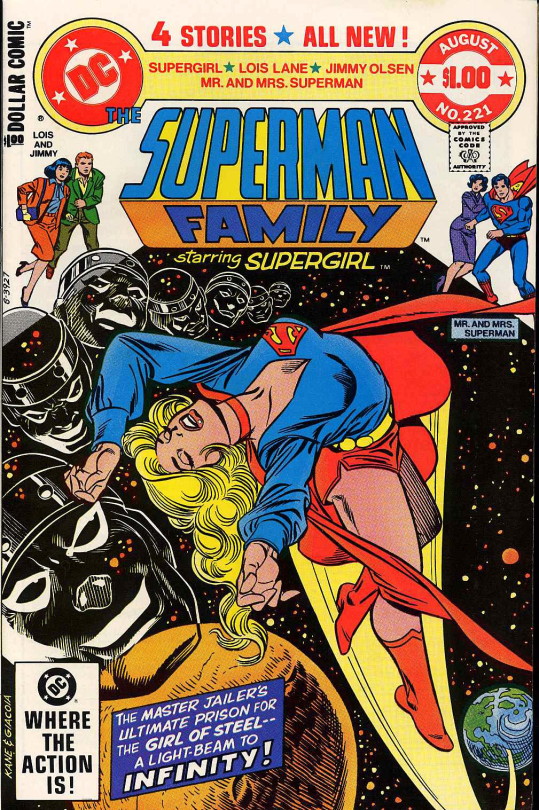
52. She was a fan of The Bionic Woman.
One of the problems of being a superhero is that your evenings are often taken up saving the world, leaving little time to catch up with popular tv shows. But on her odd evenings off-duty, what was likely to be on the Maid of Might’s tv screen? Unsurprisingly, Kara seems to have been a fan of superheroine shows, as demonstrated by comments in Superman Family #184 (July 1977) while she was battling an unnaturally fierce electrical storm in the skies over Santa Augusta. “Great way to spend an evening out”, complains a frustrated Girl of Steel, “If this storm doesn’t let up, I’ll miss ‘The Bionic Woman--!’”
53. She was a big fan of seat belts and personal computers, apparently.
Being a superhero doesn’t pay very much, if anything at all. That’s why DC Comics always liked to line up product endorsements for its big stars, and the Girl of Steel was no exception. Supergirl’s first apparent appearance in adverts (outside of selling DC’s own magazines) was in a late 70s commercial for kid’s underwear, but pretty soon DC had secured more prestigious work for Kara when in 1981 they had her extol the virtues of Tandy’s new line of 8 bit micro computers. More important work came in the mid-80s, when Kara teamed up with Honda and the US Department of Transportation to promote the adoption of car seat belts. The Maid of Might appeared in two full-length give-away comics (and on-screen Helen Slater even appeared as Supergirl in a tv advert.) Kara was so committed to the cause of road safety that she even did the second give-away comic after her death in Crisis on Infinite Earths -- now that’s dedication for you..!
54. Only one woman worked on her comic-strip during the entire Silver and Bronze age.
It is a sad reflection of the industry in the 60s and 70s that if one totals up all the writers, artists, and editors, who worked on the Supergirl strip during the Silver and Bronze Age, there’s only one female name on the list: Dorothy Woolfolk. Editor for Supergirl Vol. 1 #1 (Nov 1972) only -- yup, a single issue -- Dorothy launched the Girl of Steel into her first self-titled comicbook before giving way to industry veteran Robert Kanigher for issue #2. Allegedly a larger-than-life figure, Dorothy was a rare example of DC allowing a woman to work outside of the romance genre during the Golden and Silver Age; she is even credited by some with suggesting the idea of Kryptonite to Superman writer Jerry Siegel.
(Away from Supergirl’s own strip, two other women briefly worked as editors on comics featuring the Girl of Steel in a guest capacity. Karen Berger and Laurie Sutton both edited 1980s Legion of Super-Heroes issues containing Kara cameos.)

55. Her most iconic costume contained a pair of clocks.
The problem with slinky skin-tight superhero costumes is that they don’t leave much room for the practical necessities of life... like pockets... or watches. But that never stopped the Girl of Steel from sneaking a few hidden practical elements into her outfits. Most fans know that the inner lining of her cape hides a secret pocket (where she stashes her everyday clothes when out superhero-ing), but how many fans realised that the three discs aligned over each hip on her iconic 70s hot pants outfit actually acted as a pair of clocks? According to Krypton Chronicles #2 (Oct 1981), by placing three fingers on the discs over her right hip Kara is telepathically informed of the time in New York (her then home), while the same action on her left hip reports the time in Kandor (Krypton’s capital, famously miniaturised in a bottle by Brainiac.)
56. The USA was actually one of the last countries to see the Supergirl movie.
The Girl of Steel may have been able to zip around the world in an instant, but apparently her movie couldn’t. After opening on Thursday 19th July 1984 in the United Kingdom, then days later in Ireland and Japan, the movie slowly made its way around the world, opening in the Philippines, Australia, and Spain during August, and then France and Canada during October. By mid-November, however, American audiences were yet to see the Maid of Might grace cinema screens.
The delay was caused by Warner Bros. withdrawing from its US distribution deal near the end of production, causing producers to scramble for a replacement. Eventually, on Wednesday 21st November -- over four months after the UK debut -- the Supergirl movie hit US cinema theatres thanks to fledgling distributor TriStar Pictures, but with almost 20 minutes of material chopped out. It wasn’t until 1998 that the full international cut was legitimately available in the US thanks to an Anchor Bay VHS video release.
57. She was Wonder Woman’s sister.
Incredible as it may seem, for a brief period Supergirl was Wonder Woman’s sister. The incident happened in Supergirl Vol. 1 #9 (Dec 1973) after Kara finally had enough of being two-timed by boyfriends as Linda Danvers, and hit upon by men as Supergirl. When Kara bravely rescues an Amazon warrior ship under attack by fierce sea creatures, Queen Hippolyta offers to adopt her as a daughter, making Kara the sister of Princess Diana (aka Wonder Woman.) Realising that the Amazon’s island home is free of men, Kara accepts, but a medical emergency forces her back out into the Man’s World to seek the ingredients for a serum. With the emergency over, Kara considers that maybe she was too hasty in turning her back on all men, and leaves her new Amazon home to give them a second chance.

58. She valued her privacy.
When you have as many extraordinary abilities as the Girl of Steel, the usual fears and phobias just don’t apply. Why be afraid of heights when you can fly? Why be afraid of snakes when your skin is not only fang proof, but bullet proof? But Daring New Adventures of Supergirl #4 (Feb 1983) revealed that there’s one thing guaranteed to make Kara Zor-El flee in terror -- fear of having her everyday identity exposed. The issue sees Kara hypnotised into seeing her greatest fear by the villain Ms. Mesmer: as a result Supergirl continually sees her Linda Danvers identity reflected back at her in windows and mirrors. Convinced that everyone can see through her disguise, Kara seeks solace with her adopted parents. It is only thanks to the calming influence of her mother, Edna Danvers, that Kara has the courage to go back out onto the streets as Supergirl to defeat Ms. Mesmer.
59. Her first kiss was with a very hirsute Jimmy Olsen.
The opening season of the Supergirl tv show teased a possible romance between Kara and James Olsen, and in some ways this echos very early Supergirl stories where the pair were occasionally seen as a potential love-match. Indeed Jimmy Olsen was actually Kara’s first kiss, although the event came about in a highly unorthodox way. The pages of Superman's Pal Jimmy Olsen #44 (Apr 1960) saw Jimmy transformed into a werewolf, and Superman reasons that the curse can only be lifted by the kiss of a young girl. In steps a fifteen year old Kara Zor-El, who gives the cub reporter a delicate peck on the lips, reversing the spell. A year later Jimmy managed to turn himself into a werewolf for a second time(!) in Superman's Pal Jimmy Olsen #52 (Apr 1961), but Kara’s kiss proved ineffective that time.
60. She didn’t entirely die in Crisis on Infinite Earths.
Obviously it is a matter of record that the original Kara Zor-El gave up her life in Crisis on Infinite Earths #7 (Oct 1985) – at least until DC later saw fit to retcon that particular story line – but in their attempts to erase the Maid of Might from existence, DC had forgotten about a rather inconvenient story published just a year before, in Supergirl Vol. 2 #19 (May 1984).
The tale dealt with a Supergirl clone who had assumed the identity of Linda Danvers. The clone had no super powers, but she did have all of Kara’s memories and personality. The story ends with a twist: rather than take the easy way out by having clone-Kara conveniently fall under the wheels of a speeding bus, writer Paul Kupperberg has the two Kara’s work out a deal. ”It’s a big world out there… with plenty of room for two people with this face!“, explains Supergirl, “We can find a place for you… a name of your own…” And with that the two Karas go their separate ways, meaning that although superpowered-Kara may have surrendered her life in Crisis, powerless-Kara (her clone) presumably continued to live out a regular life anonymously somewhere in America.

And that’s it -- all sixty..! Thanks for reading, Hope you enjoyed the series and learned at least a few snippets of trivia along the way that you found amusing or thought-provoking.
Don’t forget to come back in 2048, when it will be time to celebrate the 60th anniversary of the Matrix Supergirl... Or maybe not..!
#supergirl#superhero#superman#dc#comics#superheroine#dccomics#silver age#bronze age#comicbooks#lex luthor
16 notes
·
View notes
Text
Quick Thoughts on TRR Book 3, Epilogue.
• So. This is going to be our last TRR chapter...for a while, unless they decide to do a spin-off of sorts. All the issues have been (somewhat) resolved, the MC and her friends + LI are triumphant, we've broken our beds on our wedding night, now it's time to explore the aftermath. (So sorry it took me this long, guys, I've spent a full week struggling to save whole paragraphs).
• Many thanks to @kennaxval and @boneandfur for all the screenshots and help on the Hana x MC and Maxwell x MC scenes! I used my own screenshots for Liam's playthrough, the above two + the "All the Stories Girl" YouTube channel for Hana's and Maxwell's, and the HIMEME YouTube channel for Drake's.
• So we start with waking up in our LI's arms, and it's all sweet and adorable and we're all basking in the afterglow of our first wedding night. But the LI has a surprise.
• The beach!!
• Since we'll be going on our honeymoon sometime later, the LI basically wants us to have a little fun and alone time on a private beach.
• All the LIs give us three choices of drinks (mimosas, infused water, tropical drink), and three choices of food (fruit-and-cheese-platter, french pastry and bread rolls).
• FINAL CHANCE TO SHARE AN INTIMATE MOMENT WITH THE LI!! For 15 diamonds!! That's quite a steal.
• Now...who am I to say no to a Sparkly Liam?? 😀
• So the pre-fucking activities are obviously different for each LI. It's meant to suit each of their personalities and while I loved the sex part...I really enjoyed this.

Liam takes his wife swimming (you can either splash him or take him underwater for a kiss) and then proceeds to write a love note for her in the sand. When she points out that it might get washed away in the sand, he states that the message will live on in the waves that will carry it. Gaww.
Hana's activity is SO HANA istg. Both she and the MC build a sand castle and you get a rare glimpse of "Hana-getting-carried-away-talking-about-things-she-loves" if you choose the fairytale option xD They build a castle and a moat, and it's pretty obvious that Hana loves her fairytales ("there's no such thing as too many castles") and that the activity is so representative of her wildly romantic spirit.
Maxwell agrees to get buried in the sand, and the MC can choose what form it should take (Valtoria's sigil, a sea monster or a lot of muscles). @boneandfur tells that if you choose the sea monster option you get the first mention of "unleash the kraken" if you are married to him (the first one was in the fling scene, which you obviously won't get if he's your fiancé). It's all sorts of adorable 😂
Drake has a swimming race with you, in a rather nice callback to his first beach scene (diamond-option) in Book 1 Chapter 10. Back then the race was between Drake and the MC, Hana acting as referee and producing a shell for her and a sand dollar for him later on as prizes. Here, the MC has the option of gifting Drake a beautiful conch shell, and Drake is the one who gives the MC a sand dollar.
• Guh. That's all I'll say about what follows. Guuuuuuh.
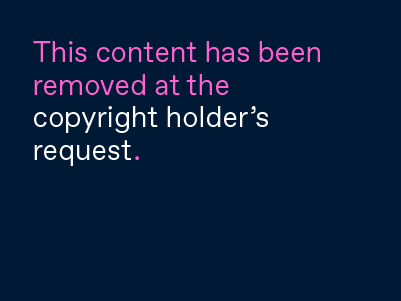
• I made Esther wear her hugeass hat just to see if she'd keep it on during sex. She didn't and now I'm very sad 😟
• It's now a few weeks later, and we're being called for a special secret ceremony that Liam has gotten planned, and that apparently only Madeleine knows (very very few) details of. You get to tell your friends (in your fiancé/e's presence if you're not married to Liam) how married life is going for you, and there's either some good natured teasing or "ugh, spare me the details" from them. Madeleine then enters, having found the perfect excuse to wear the white dress I pettily didn't allow her to wear to my wedding.

I bet my note said "pay diamonds or it's the LBD for you, bitch".
• I also love how Madeleine knows that asking Olivia not to bring daggers is a lost cause, so she might as well put a limit of the number of weapons she brings instead 😂😂
• Out of the four, two already decide on their outfits (Drake on his grey suit and Olivia on her Costume Gala Nevrakis gown), and two ask you for your opinion.
• For Hana, you can choose between the handmade cheongsam that is so precious and personal to her, and the godess-of-spring gown she wore for the Costume Gala. If you were married to her, or chose another dress for Hana to wear, the cheongsam would be perfect!! Imagine, when she finally receives honours for her contributions to her country, she will be wearing this lovely dress that has so much personal history for it and possibly may also be representing her roots as well. But I chose the spring gown, because the cheongsam she'd worn for my wedding. If I ever wind up replaying maybe I'll switch it all around a little.
• For Maxwell, you either choose between his smart black suit, or the squid suit. OF FUCKING COURSE I'm going to choose the latter. When he goes up to get his honour as Guardian, I want everyone to know that this Beaumont Boy is the Pride of His Home and His Family 😍 Same with why I'm happy that Olivia is wearing her Nevrakis gown because this event is further proof that she is redefining what it means to be a Nevrakis. (also if you choose his squid suit, he exclaims in squiggly letters about how the "cephalopod rises again". 10/10).
• For Drake, I like the full-circle enforced by the fact that this suit was what he wore on the night of Liam's Coronation. That night was the first time Drake didn't try to reject his feelings for the MC, didn't allow his guilt re: Liam to come between them, instead accepted that he felt that way and approached her (in his diamond scene). Given that this epilogue features a throwback to the Coronation...I like this extra touch.
• My corgi Joy DuPont of Valtoria/Cordonia gets his own suit too.
• Aaaaand now it's time for the finale gown!

Pretty faithful rendition of the gown on the cover, and I think it has elements of both sigils just to keep us covered either way. The gown is a rich wine/burgundy colour, gold swirls at the skirt and jewelled gold belt (phoenix sigil) white/silver-ish coloured elements on the neckline and cuffs (dove sigil). Madeleine tells us that the gown was made keeping our house colours in mind. The LI - if they're in the boutique - gets to gush, and Olivia is the only friend who gets to comment by default - very possibly because she shares a common house colour with the MC, and either woman will get to be his Consort. Alongside the Coronation Ball parallels, you can see parallels to the Costume Ball as well!
• If you're married to Liam, and therefore Queen of Cordonia, you get an extra (and free!) selection to make: your tiara! The book gives us four options:
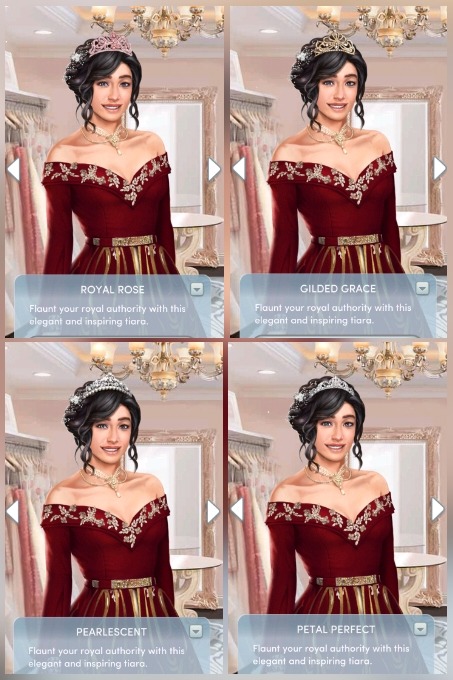
I honestly don't know what they're supposed to symbolize really, and I don't think they would actually symbolize anything. They're just pretty headpieces meant for the country's new queen. But Ima list down what these tiaras remind me of!
Royal Rose. The "Romantic Love" pink ballgown option for the Homecoming Ball, which was Hana's choice of outfit back then and comes in her favourite colour, pink. It also reminds me of Liam, because in the beginning especially he was often associated with roses.
Gilded Grace. A gold tiara with gems embedded. The design is exquisite and intricate. Kinda reminds me of that nice gold watch Drake gifted us, but also the top half of it reminds me of the flare of a peacock's tail, so I'm also reminded of Maxwell 😄
Petal Perfect. I think it's called so because of the flower motif in the centre, surrounded by serrated edges which seem to me like leaves. I would definitely be reminded of Hana, who is associated with flowers in general!
Pearlescent. There is only one person I can think of who this tiara would remind me of: Liam! The pearl plays such a poignant part in their story if you chose that scene, because Liam found it at the Blue Grotto before he had ever met the MC, and showed it to her when their relationship was going through rough times in Capri. Back then, there was the option of rejecting it, keeping it or asking him to keep it safe until they were free to pursue their relationship.
• I had a headcanon that Esther asked Liam to keep the pearl, and that he had it placed in a tiara of hers to show her how far they had come together, and how much hope she had instilled in him. So OF COURSE I would choose the pearl tiara xD The writers seem to have forgotten about that Blue Grotto pearl, but I haven't!
•

Liam's outfit at this ceremony mirrors the MC's: burgundy with gold designs and leaf motifs. I see this as parallel to two events: the Costume Gala, where his "King Fabian" outfit matches both Olivia's and the MC's (that one mirrors Olivia's better though, because it's a bright red and not saffron-with-red-notes like the MC's avian gown). I also see this as parallel to the Beaumont Bash: where you can persuade Liam to show his support for you by wearing the Ramsford Duchy house colours of blue and white. Here, the ceremony itself seems centered largely around the MC - what with her being given the country's highest honour - so it could either be a show of unity (as a couple) or solidarity (as Liam showing his support to the MC). I also wonder if this is why Olivia is automatically given the red gown to wear, since they seem to be at least close to dating now if you're not married to Liam.
•

Interestingly the group receives honours based on their defining characteristics, which seemed to have helped in various ways in the fight against Anton. It's also a nice way to finally wrap up all their individual arcs, and validate them in the face of all the doubts they'd had about themselves throughout the series. Maxwell needs to see himself as good for being who he is, not have to transform into someone else altogether, to be seen as a person with something valuable to contribute. Hana still needs to navigate who she would like to be, and how she would like to live her life, and this title is an incredible step forward. Drake has had the most to prove in this book, making it clear that as a commoner he is important and that the nobility need to change their outlook towards commoners in general. Olivia is still redefining what it means to be a Nevrakis and to prove that her family name can be one that stands for loyalty and honour, not treachery.
• The Champion of the Realm title is given to the MC regardless. Even in a fail playthrough she gets it, and I think that's mostly on the basis of the very last scene, since Anton is vanquished by default. Does it ring false? Hell yeah it does. On one level that's the way the story goes, on another - it makes everything EVERY member of our core group says about her sound absolutely weird.
• Why does she get a higher honour above the others? You actually get the chance to ask Liam that. And he does respond - both in his speech during the ceremony, and later on.
Speech: He mentions her position as an outsider in this country and how she has embraced Cordonia as her home, but also speaks of having fought for Cordonia and unified it as a country. The second definitely seems to be the overriding theme when it comes to her: the ability to unite people to a cause.
Do I Deserve This? This is a question the MC has the option of asking Liam after the ceremony, and he stresses again on her working as a unifier. Her quality is not as much intelligence, or bravery, or strength - it's the ability to inspire people to reach their highest potential. He speaks of it as "You don't just make Cordonia better, you inspire us to become better ourselves". Which, if your MC is just all-round horrible to everyone and doesn't even have people come for her wedding, is a load of horseshit. Stop being nice to her Liam.
• Ana de Luca referring to our social season moniker in Book 1 (Mystery Woman/The American) was a nice touch.
• Liam also (finally!) addresses in public the vast imbalance between the nobility and the common populace, and how he would like to change that. I've seen complaints that he has basically "placed his buddies" in the Council, so he is essentially making the same mistake - but I can only see that argument as valid if a. those "buddies" weren't involved in the eventual takedown of Anton, and b. you ignore what he says about getting a roster of candidates ready for the council itself. It's still an ongoing process, so us jumping to criticize something that's just been announced is a little premature.
• Ana says we haven't ever had a council...which makes me question how much of Book 1 the writers have forgotten, honestly. Because...like...
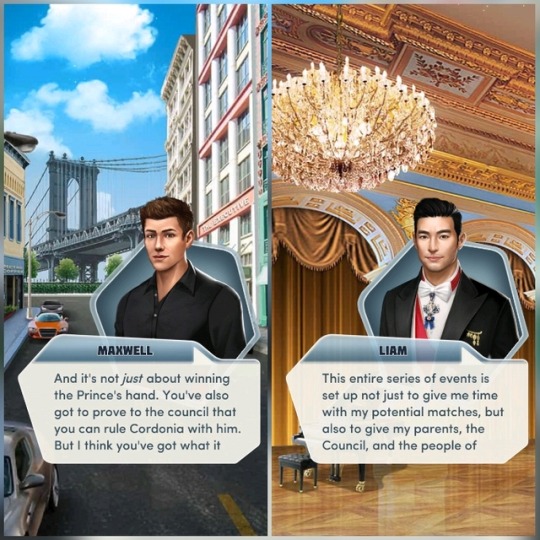
Both screenshots are from the initial chapters of Book 1, mind you. They're possibly not the same as the Council Liam is planning on, but they're definitely there - just that they're invisible! Like the Cordonian populace for most of this series.
• Time for a Ball!!
• Since this is the epilogue, the Honour Ball (which is what I choose to call it rn) harks back both to Liam's Coronation Ball, and to the Masquerade Ball that introduced the MC to the nobility in the first place. The first half is a conversation between the MC, Olivia and Hana (parallel to our very first scene in Book 1, which is Hana congratulating the MC and Olivia maintaining that no matter how attractive she may seem to the Prince, she doesn't have what it takes to be chosen). Hana was sad about the prospect then, but happier for their friendship now. Olivia jealously dismissed the MC as not worthy of Liam then, but accepts that she is worthy of the honours bestowed on her now. Even the MC's responses now parallel the Coronation Ball: a gracious response, a threatening response, and a response that implies closeness ("I would rather date you"/"Just shut up and give me a hug").
• The second half of the Honour Ball scene is the LI dancing with the MC. At the Coronation Ball, this moment was our introduction to Liam, but now our respective LIs come forward for our first dance. In those playthroughs, Liam immediately asks Olivia to his first dance instead. The conversation then turns to their first Ball (Masquerade) and explores the LIs' initial thoughts on the MC.

Liam speaks about how there was a mixture of concern and love in his feelings for the MC. Hana speaks of how the MC transformed the way she looked at herself. Maxwell speaks of wanting the MC from the very beginning but withdrawing because he believed she was meant for Liam, not him. Drake speaks of how wrong he was in believing the MC didn't have what it took to survive, and how proud he is that she doesn't need a protector. All in all, toothachingly sweet 😊
• "I'm ready to do a lot more than dance". Esther is thirsty, from her first scene to her last 😂
• Alright so we now go a whole bunch of extra scenes meant to wrap up everyone's story, and I'll begin with the animals and Olivia before moving forward to the LIs.
Pets: Joy (the corgi) is found raiding the kitchens and making a mess, and in a very fun scene, the MC gets to set a few (very funny) ground rules. The first set deal with house behaviour, the second deal with their interactions with the non-royal LIs, and the last deal with some funny rules about the dog in Cordonia, including not getting involved with cults or overthrowing Liam. It ends with the caption "12/10 The Goodest Boy" (I'm inclined to agree 😄). There's a tiny scene involving Celestia (the horse), Hansel and Gretel (the red pandas), where the MC steals a moment and makes them lovely promises of pampering. All of these scenes are included if you buy all these pets - a little bit like that bonus scene involving Bubbles and the Mechawolf in TCaTF.
What I Think: These are not meant to be very deep - they're just fun, playful little bonus scenes meant to bring a smile to your face, and these scenes definitely succeed in that.
Olivia: This scene involves Olivia regaling Kiara and Penelope's families with the tale of Anton's defeat, and I believe it's the first time we see both families together (they've shared the same spaces but not exactly been shown talking to each other). The futures of all the three ladies are outlined: with Zeke disinheriting himself to become a vet, Kiara now gets to be next in line for running Castelsarreillan after Hakim, as well as the diplomatic liaison on the Royal Council. Penelope will now be a dog fashion designer with plenty support from Joelle, and possibly marrying Ezekiel. Olivia will be meeting Liam to discuss the dissolution of her marriage to Anton, and if you married someone else she will be doing it over dinner, which suggests the beginnings of a romantic relationship. She also plans to tour Lythikos in the aftermath of what Anton and Lucretia have done, and make sure that there are no more rules and stipulations from Lythikos that will pose a problem for Cordonia itself.
What I Think: I like how this wraps up several things at once and brings back that initial conflict of what Zeke's decision to be a vet (even though, frankly speaking, I kinda wish he didn't exist). The highlight was the sincerity and passion with which Olivia plans her next steps for her duchy and country. This scene neatly ties up all the women's stories with satisfying resolutions: the most satisfying of all being that Kiara is justly rewarded for all her hard work. I do take issue, however, with how the writers use Kiara to sugarcoat how terrible the MC and her friends were to her, in front of her mother Joelle. Then again it's not like the MC was particularly honest about her motives for talking to Kiara in Lythikos but...the last thing I want to see is Kiara giving credit where it is not due.
Drake: You begin by talking to several people: Gladys if you took her diamond scene and set her free, Mara, and Drake. Bastien is present, but he speaks more to Drake than to you. Gladys gives you an update on her life and thanks you for giving her a second chance. You get to either thank Mara for "risking her life" or tell her she sucks at her job. Drake talks to a number of people: Bastien, Neville and Rashad. Bastien reveals to Drake that his father was also once Guardian of the Realm (why was his family almost cast out so cruelly then, if what Jackson did was so phenomenal that he got this honour for it?) and would have been proud of Drake today. Neville apologizes to both Drake and the MC, and depending on the MC's response either walks away on good terms or acts like the spoilt brat that he is. Drake then reveals to the MC that she was his inspiration for taking up the Council Seat and that he wants to do more for the common people of Cordonia. Just seconds later, he gets his chance to make a change when Rashad comes forward with a proposal to use unused lands in the duchies to make public spaces for the people, a proposal Drake is only too happy to be involved in.
If you are married to Drake, there is acknowledgement all round of his new position, one extra dialogue from Neville if you respond positively to him, and it changes his dialogue with the MC just a wee bit.
What I Think: What makes Drake's scene so special is the fact that it, by far, most effectively shows the change in nobles' attitudes towards commoners. It is also symbolically important that it happens at the place where the MC sees the palace for the first time with both Maxwell and Drake, AND where Neville and Drake once duelled (and Neville acknowledges this). This is where Gladys - the representative commoner - chooses to thank us and assure us of her support. This is also where we have the chance to take our security detail to task if we so choose (we all thought she was going to be proven as shady and as a traitor...turns out she was just inefficient). The cherry on top is Rashad - the rebel heir - approaching Drake with something that will benefit both nobles and commoners. It kind of shows us the true triumph lies here, in giving to the common populace before unscrupulous elements can sway them. Could this have been done earlier? Of course! But I feel like narratively this is more effective.
Maxwell: For one, thank God Maxwell isn't a surgeon!! This scene includes BertVannah, Bartie and Maxwell, and delves into the upcoming wedding, Bertrand recognizing that he doesn't need to be as hard on himself and his brother as he was in the past, and Maxwell revealing that he's going to write a book about the MC's rags-to-royalty tale. Bertrand is now happy to be honest about the state of his financial affairs and his determination to keep Savannah and Bartie happy. He also gives Maxwell the chance to handle his own finances independently.
If you're married to Maxwell, you get to refer to Savannah as your sister-in-law, Maxwell speaks about your love "changing along the way" if you married someone besides Liam. In his playthrough he speaks of the book as their love story.
What I Think: Overall the Beaumont Brothers storyline got some amount of buildup but very little resolution. We don't know what pushed the House into financial ruin, we don't know the history behind them as we should considering we're an honorary family member, we're never told the secret things that Maxwell hinted at in the Shanghai Night Market group scene in Book 2. The book and its proceeds is said to be the key to restoring their House to its former glory financially, but that's just a very odd way of ending that arc. On one hand I'm glad there is a resolution, on the other it seems a little weak to me.
Hana: Hana is seated at a piano in front of her parents, Madeleine, and Madeleine's parents. Lorelai repeats the mistakes she'd made in Hana's childhood, trying to push Hana into parading her skills in front of guests. Hana refuses without much success, but Lorelai doesn't seem to be really listening to her. At this point, the MC gets to intervene and Xinghai agrees, leading Hana to open up about wanting to share her skills by choice rather than being forced to do so, and Lorelai apologizes...yet again. There is some talk about parenting from Adeleide and Godfrey who are watching this exchange, and we find out that Madeleine is now Royal Communications Director. Once the parents have left, Madeleine stays behind to apologize to Hana for the bullying she meted out to the latter during the Engagement Tour, and Hana tells her that Madeleine will have to earn her forgiveness. Madeleine then promises to ensure that no one harms Hana in court (hah). Once she leaves, Hana joyfully plays piano for the MC herself.
If you're married to Hana, the end of the scene has a few changes. Instead of jokily throwing pillows at each other, they jokily argue over who the best wife is instead (for each, it's the other). The tune Hana plays for the MC as her wife is different from what she plays as her friend. The friend version has her play the upbeat TRR theme tune, and the LI version has Hana play what the narrative calls a "slow, sultry tune"...which turns out to be the mournful TRR theme tune. What, is being married to Hana supposed to be an occasion for sadness now?? Because you're definitely succeeding in making it look like that.
What I Think: I guess I should be happy that Madeleine's behaviour was addressed at all, though it was clearly a rushed, last-minute job that happened because of some amount of arm-twisting. It's also nice that they bring us full-cirlce by referencing Hana's piano scene in Book 1, and showing that rebuilding her relationship with her parents (she shouldn't have to, but this is clearly the way the writers WANT to go) is going to be an agonizing, painful process. They show the parallels between Hana's upbringing and Madeleine's upbringing as well - it's not a parallel I'm happy seeing, but I was aware they were going to take that route way back in Book 2.
That said, there are things that won't let me enjoy the scene. One is that at this point, I'm not seeing Lorelai learning or growing enough. I know this might be an attempt to show that these things take time, but the Lorelai scenes are honestly getting repetitive and exhausting. And as someone who has been where Hana has been? Right down to family members who accept they need to be better but don't actually? I can tell you it's fucking exhausting to have to deal with that again and again and again. For Hana's sake at least I wish I could actually see her LEARN from what she's done and ACTIVELY DO SOMETHING ABOUT IT.
Now we go to my biggest problem with this scene. Madeleine.
It's good that she confesses to her motives and accepts Hana's decision. It's good that Hana gets to be firm about not forgiving her until SHE is comfortable doing so. It's good that Hana sees her own forgiveness as something that should be earned - not by a paltry two-minute apology but through genuine effort. But the problem for me lies in two areas:
1. Madeleine's Excuses: That's exactly what they are - excuses. Madeleine claims that she wanted to "break" Hana in an effort to get her to shed her "nice act". Which is bullshit. Even if Hana's kindness was an act...was she hurting anyone? Was her "act" actually causing harm? Madeleine's actions exceeding even Hana's perceived crime. What business was it of Madeleine's to rip this woman apart based on her own assumptions? And if she recognized that Hana was genuinely good, why was she okay with minimizing what she did to her? We can bring a thousand excuses about her sexuality and her upbringing and how hard all of this was - it doesn't make the gravity of what was done to Hana and the ridiculousness of Madeleine's claims any less.
2. The MC's Fake Self-Righteousness: This bit was perhaps the most jarring part of the entire exchange. By default, when Madeleine speaks about wanting to break Hana, the MC seems furious. But it's more than that. The MC sounds like she's hearing these words for the first time.
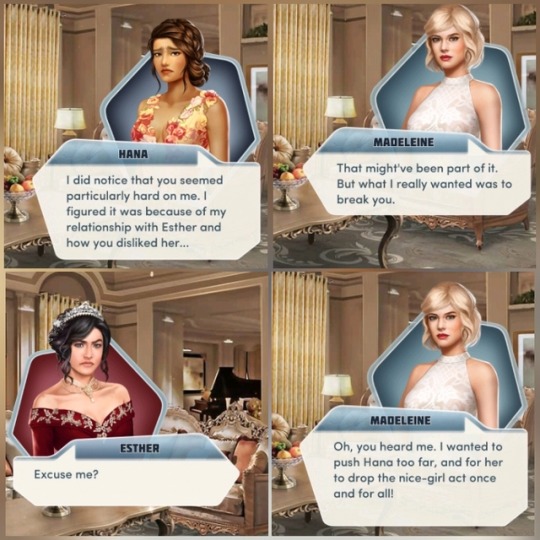
The only good thing about it is that Madeleine calls her out on it. But besides that, it just...makes all the MC's claims about being there for Hana and having Hana's back ring so false. One of my biggest problems with this whole series of events was how much the MC herself minimized and diluted what Hana went through at Madeleine's hands. How little she seemed to care about arming her friend with the entire, unvarnished truth. To have her act all protective in front of Hana now, to pretend like she'd never heard those poisonous words...that's just a whole other level of shady. It reflects even worse on the MC if they're married, because dafaq kind of wife are you if you couldn't arm your wife emotionally against this snake of a human being? That would be a major disservice to Hana-romancers who hated the way Madeleine treated her, and Hana stans in general because they weren't given a fair chance to properly protect and support Hana. Instead for the most part they'd be forced to choose the least worst options, rather than ones they were truly happy with. It sucks.
Liam: A short but significant scene. You find Liam in conversation with his stepmother Regina, and greet them. She is happy and proud of Liam and the MC, and everything they have achieved. She thanks you, and you can choose to either respond positively or maintain that she should have trusted you in the first place. Either way, she responds with grace, and then leaves. You speak about not having seen the throne room much, and Liam opens up to you about not being able to come here without being haunted by his memories of his father. He confesses to struggling with moving on from Constantine's death, understandably, and for the first time, feels safe enough emotionally to cry in the MC's presence.
If you're married to Liam, Regina speaks about how you two as a couple remind her of herself and Constantine, and expresses happiness in the changes you have brought about in Liam. Furthermore, the conversation about Constantine is extended to involve Liam and the MC's own plans for a family, and how they will strive not to repeat Constantine's mistakes. This is a fitting throwback especially to the date scene with Liam, where he speaks about how he wants a family where everyone is open to each other.
What I Think: I'd been silent for a long time about things in Liam's storyline that have disappointed me, mostly because I felt that given my LI was the central LI I fared better than most (and it's true - I did). But it doesn't change the fact that I am disappointed they didn't explore his potential. Neither his fiancée nor his friends nor his family paid enough attention to his own emotional state, and where the narrative could have had us tackle his demons they failed in creating opportunities for us to do so. A single tear slipping down his cheek is something, but to me it presents similar issues to Hana's last scene - that it is a rushed job of a journey that could have been resolved step by step, that could have been given some attention. I'm happy we got to see the statesman behind the lover, but doesn't mean it should be one or the other. There was enough room to balance out both and actually address his trauma and his health, yet it was ignored for the most part.
That said, this scene was poignant on its own, and I always love it when there are little moments of bonding between Liam and Regina, because I think that relationship itself is quite underrated.
• Now that we have finished checking up on everyone, we take one last look at the ballroom that held so many memories - sweet and horrific - for us, before Mara tells us it's time to get into the carriage for our honeymoon.
• We say goodbye to all our allies first (and get to hug Olivia if we want), and then to our friends who are waiting at the carriage. There's a lovely little group hug, and if you bought the horse she will be the one drawing the carriage. If you've bought the corgi, he also gives you a fond goodbye before you leave. As do the Cordonian citizens by default.
• The carriage scene is a beautiful private moment, because each LI gets to explore the moment they first met the MC, and how incredibly fortunate they are to have been on this journey together. All of them speak of the incredible odds they faced together, and how they will be willing to face them all over again if it meant a lifetime with the MC. It's a touching emotional moment, and all the four scenes have been written lovingly. The final lines of this book are the kind that stay with you, long after the book is finished:
LI: Is this moment everything you wanted it to be? (or some such variation, depending on your LI)
MC: No...it's better.
General Thoughts:
• Even if you choose every single wrong option possible, the story ends well for you. You don't get people to support you and very few people besides the ladies of the court and your immediate friends and LI's family make it to the wedding, but somehow they magically appear at the reception. Regardless of how badly you performed, your final actions fighting Anton earn you the Champion of the Realm title anyway, and in this case it's an unfair advantage to give. But the thing is this: every single LI in this group showers praises over you no matter what you do. That's the way this particular story goes, and it's written such that it won't go any other way no matter how much you try. The MC in a lot of cases is a reflection of the player, and at the end of the day I think they want the player to leave this story happy with their journey, even if it's too ridiculous to be true.
• This is a fitting end to the series overall: it allows us to explore everyone else's endings, has great parallels with the past, and allows us enough wiggle room to imagine our MC's future with their spouse. With regards to QTs, I still have Book 1 to complete, but I'd like to get some distance from the series itself first before I tackle it again.
Final Thoughts:
When I started this book last year, I got in completely expecting to be bored. Bored and totally not invested. I gave my MC the name I felt the least connected to (Alice Bennet), and barely gave much thought to which LI I would pick. However, something always brought me back, something always got me looking forward to the next chapter. Thus began my love affair with this book.
There are a lot of reasons why this book grew on people. The intrigue hidden behind this fairytale-like frame story. The little connections between this series and TCaTF, one of their most popular flagship books. The camaraderie between the members of the core group themselves. The way even the not-so-nice characters grew on you. The way each LI had something unique to bring to the table. Somehow...even the people who couldn't be bothered about the series could find something they would have even a passing interest in.
Do I miss this book? A little. This book got me back into writing essays - something I always loved doing - and fanfic. I got to learn so much, explore so much, and contribute so much thanks to my fondness for it, and for the fandom that seemed to love it as much as I did.
Am I sad it's gone? Well, in some ways yes. But I'd rather it did when it had to instead of being dragged along, and I would rather not see the writers destroy the characters they had zero interest in, further (I love this book - but I also love it enough that I will never forget to point out where it fucked up). I think it had a good run, lasting more than a year, and it ended well.
For better or for worse, I'm glad I got to be a part of this journey.
#the royal romance#long post#Liam x MC#king liam#hana x mc#hana lee#Maxwell x mc#Maxwell beaumont#drake x mc#drake walker#Olivia nevrakis#bertvannah#Bertrand Beaumont#Savannah walker#lady kiara#lady penelope#countess madeleine#trr quick thoughts#quick thoughts
71 notes
·
View notes
Text
The TV Show Trials - Law & Order: Special Victims Unit
Based out of the New York City Police Department’s 16th precinct in Manhattan, Law & Order: Special Victims Unit delves into the dark side of the New York underworld as the detectives of a new elite force, the Special Victims Unit, investigate and prosecute various sexually-oriented crimes.

This is the second part of this month’s TV Show Trials – Double Feature. If you would like to read the first part, where I reviewed Law and Order, you can find it here. As stated in the first part of this review, Special Victims Unit is my favourite of the two. As always with anthology series, I will give my opinions on each episode individually before summarising my thoughts on the series at the end.
American Tragedy
A celebrity Southern chef shoots and kills a teenage African-American boy that she thought was a serial rapist. But was her life in danger, or was she just an over-reactive racist?
This episode is based off of both the shooting of Trayven Martin and several racist remarks made by Paula Deen. This is a good episode overall, the perpetrator is very easy to hate due to her ignorance and blatant racism.
Funny Valentine
Can SVU convince an up-and-coming singer to break away from her abusive hip-hop singer boyfriend before it is too late?
The parallels between this episode and the incident between Chris Brown and Rihanna are loud a clear, so much so that they name drop the real-life inspiration in the episode. Once again, the perpetrator is very easy to hate, and though I tried my hardest I couldn’t help but blame the victim slightly for what happened to her in the end.
American Disgrace
A basketball legend is accused of raping multiple women, but exactly what role did the powerful CEO of the sports apparel company who had a contract with him play in the situation?
The immediate ties between this episode and its real life counterpart are harder to spot due to the fact that it mixes together elements of multiple cases. This is most likely the reason that I found this episode less enjoyable than most others.
Pornstars Requiem
Two college students are accused of raping a classmate who had appeared in a series of violent online pornographic videos.
All this episode left me thinking is: can’t people just treat sex workers like they’re normal people (because they are). Just because someone works in the adult entertainment industry does not mean you can assume what rights they do or don’t have. This episode did bring another main element forward, it was this episode that finally gave me a favourite character, Rafael Barba.
Influence
Rock star Derek Lord goes on a national talk show and lectures about the abuse of psychiatric drugs. Meanwhile, an unstable young woman loses her virginity, goes off her prescribed medication, gets behind the wheel of a car, and mows down 10 people. As these events are played out in a highly charged way, the argument about prescribed “meds” is challenged.
God, this episode pulled some very strong opinions and feelings from me. I don’t think I can support Tom Cruise, as an individual, after learning of his blatant disregard for the psychiatric profession. Apart from the Tom Cruise inspired elements, this episode is an original concept separated from famous events and it raises a serious debate about whether you can convict someone who is affected by mental illness that inhibits their reasoning abilities.
Sick
Two children claim that they were molested by a billionaire.
Before this episode, I had no clue that there where paedophilic allegations towards Michael Jackson; call me ignorant all you want. I won’t present my personal views on the real-life situation here; but I might in a full review of Leaving Neverland. But, I can say for certain that this episode left me feeling sick.
Blood Brothers
A pregnant 13 year old girl from Washington Heights claims that the son of an ambassador raped her, but the accused goes missing before SVU can question him.
I never thought I would watch something where the main premise is that of a child killing another child, but here I am. This episode drew inspiration from the Arnold Schwarzenegger scandal from 2011, where he cheated on his wife with a housekeeper who then becomes pregnant with his child and has him play the mother for child support. All these elements are used in this episodes, with an extra sprinkling of child murder to spice things up a bit.
Personal Fouls
SVU investigates an accusation that a revered high school basketball coach sexually abused his players, but they ultimately may need the cooperation of a reluctant pro superstar to make case.
This episode brought with it some ups and downs, it contained my first recognisable celebrity cameo with Aaron Tviet and the main disappointment that there were no court scenes; which are easily my favourite parts of the show.
Selfish
An immature, irresponsible young mother is assumed to have killed her child, but it turns out to be part of a measles outbreak. A.D.A. Cabot then goes after the mother of the child who started the outbreak, who refuses to immunise him.
This episode features another easily recognisable celebrity cameo, Hillary Duff. This episode combines the polarising anti-vaccination community and irresponsible mother Casey Anthony; who killed her daughter so she could have a social life. This episode is packed with drama and entertainment value as we encounter twists and turns with this case.
Game
The squad is at a loss on what to do with a violent homicide when Stabler’s son points out that the event is straight out a video game. Interviewing the game’s creators leads them to a former employee, who then leads them (with a few other steps along the way) to a teenage couple who claim to be unable to distinguish fantasy from reality.
This was probably the least entertaining episode of those I watched. This episode doesn’t revolve around a specific crime, but the topic of violent video games; specifically the Grand Theft Auto franchise. I wasn’t very engaged throughout this episode, as it lacks a clear through-line to keep my attention over the course of it.
Monogamy
The case involves the beating of a seven-months-pregnant woman, whose unborn child has been torn from her body via a primitive caesarean section. Among the many witnesses questioned is the woman’s husband, a psychiatrist with several devastating secrets and knows more about his wife’s beating than he’s willing to admit.
This episode has, hands down, the best ending out of all the episodes I watched; and is maybe my favourite episode from SVU.
Babes
The grisly murder of a homeless man leads detectives to four high school girls with a pregnancy pact. But after their pact is revealed, somebody drives the girls’ ringleader to an apparent suicide.
The only note I made about this episode was the boyfriend of the ringleader acted well, so this episode must have been pretty average for me to not write anything else.
Imprisoned Lives
The case of an abandoned seven-year-old boy in Times Square leads to the shocking discovery of two women locked in a basement cage by their abductors for nearly a decade.
The obvious inspiration for this episode was Ariel Castro. I somewhat enjoyed this episode, but while watching it I couldn’t help but think of Room.
Scavenger
The entire SVU squad races against the clock to solve the puzzles and uncover clues scattered throughout NYC by a serial killer who is taunting then to find him and the next victims on his list.
This is a really good episode that kept me on my toes the entire time. I don’t have much else to say other than this was the best episode I watched; hands down.
Head
A coprophillic Cyber-Peeping Tom catches a child abuse case on video.
This is a mildly interesting episode based on the Mary Kay Letourneau case, who raped and was impregnated by their 13-year-old student. Though, the episode incorporates a brain tumour that caused the perpetrator to have paedophilic urges, which is extremely interesting.
Overall, I like SVU more than it’s predecessor and I am quite likely to continue watching it; but casually, as compared to full-time.
2 notes
·
View notes
Link
U.K. Charges 2 Men in Novichok Poisoning, Saying They’re Russian Agents
LONDON — The two assassins sent to southwest England in March to poison a Russian former spy were active officers in Russia’s military intelligence, Prime Minister Theresa May of Britain said on Wednesday, after prosecutors accused the men of attempted murder, the first criminal charges in a case that has driven a deep wedge between Russia and the West.
Investigators released a cache of evidence in the case, including security camera images that captured the progress of two husky men from an Aeroflot flight to the scene of the crime, near the victim’s home, and from there back to Moscow.
They also released photographs of the delicate perfume bottle that was used to carry a weapons-grade nerve agent, known as Novichok, to the quiet English cathedral city of Salisbury.
British counterterrorism police said at a news conference that they had pored through thousands of hours of security-camera footage, cross-referenced the results with passport data, and on May 2, identified a shabby hotel in East London where the men had stayed. Finally, in a needle-in-a-haystack moment, two swabs taken from the suspects’ hotel were found to contain traces of the nerve agent.
Addressing Parliament a short time later, Mrs. May said that parallel to the police investigation, British intelligence agencies had conducted their own inquiry and concluded that the two men were “officers of the Russian military intelligence service also known as the G.R.U.”
“This was not a rogue operation,” she said. “It was almost certainly also approved outside the G.R.U. at a senior level of the Russian state.”

She said the nerve agent attacks were of a piece with a long string of Russian operations spearheaded by the G.R.U., including the seizure of Crimea, incursions into eastern Ukraine, the downing of a civilian airliner in Ukrainian airspace, and an attempted coup in Montenegro.
The allegation of specific G.R.U. involvement in the use of the nerve agent adds to the heightened tensions between Moscow and the West, which has led to mutual expulsions of hundreds of diplomats and embassy employees, and to sanctions against Russia.
he G.R.U., now known as the Main Directorate of the General Staff, serves as an undercover strike force for the Kremlin in conflicts around the world. Some of its officers were charged in July by United States prosecutors with hacking Democrats’ computer systems during the 2016 presidential campaign.
The British authorities issued domestic and European arrest warrants for the two men, identified as Alexander Petrov and Ruslan Boshirov, and released photographs of them. The men traveled on valid Russian passports on those names, the police said, adding that they believed the names were aliases.
“We do understand they have traveled extensively in the past under these aliases,” Neil Basu, Britain’s top counterterrorism police official, said.
The information released on Wednesday made clear that investigators had known of the men’s assumed names, their movements and the contamination of their hotel room for months without saying so publicly. On Wednesday, they appealed for the public’s help to fill in the gaps about what the men had done, and when.
“The names, as well as the photos, published in the media mean nothing to us,” Maria Zakharova, a spokeswoman for the Russian Foreign Ministry, told journalists on Wednesday. “We once again urge the U.K. to switch from public accusations and informational manipulations to practical interaction between law enforcement agencies.”

The Crown Prosecution Service charged the men with the attempted murder of the Russian former intelligence officer, Sergei V. Skripal; of Yulia S. Skripal, his daughter; and of a police officer, Det. Sgt. Nick Bailey, who was sickened while investigating the case. The men were also charged with conspiracy to murder Mr. Skripal; use and possession of the nerve agent; and causing grievous bodily harm.
The charges do not address the poisoning of two Britons — Dawn Sturgess, who died, and Charlie Rowley — though investigators believe the events are linked. Both Ms. Sturgess and Mr. Rowley fell ill months after the attack on the Skripals, when they found the perfume bottle that investigators believe was used to transport the nerve agent.
“The same two men are now the prime suspects in the case of Dawn Sturgess and Charlie Rowley,” Mrs. May said, adding that the same poison was used in both cases and that the two were “victims of the reckless disposal of this agent.”
Prosecutors did not request the extradition of the men from Russia, which does not send its nationals abroad for prosecution. Mr. Basu said that, while he hoped for arrests, “it’s looking very very unlikely that we are going to get to that point.”
The images released by the police show how easily the attack could have escaped detection. The suspects look perfectly ordinary, strolling in wintry weather in jeans and parkas. The police released pictures of the counterfeit bottle for a perfume, Nina Ricci’s Premier Jour, and a pearlescent pink box that contained it — a container so innocuous that Mr. Basu called it “the perfect delivery method.”
Mrs. May said, “the manner in which the bottle was modified leaves no doubt, it was a cover for smuggling a weapon into the country.”
All five victims were poisoned with Novichok, a class of nerve agents developed by Soviet and Russian scientists, according to British government scientists and the Organization for the Prohibition of Chemical Weapons, the international agency that monitors compliance with a global treaty on chemical weapons.

Britain won backing from its Western allies for the conclusion that Moscow was behind the attack, touching off the latest in a series of diplomatic breaches between the Kremlin and the West.
After the attack on the Skripals in Salisbury, a cathedral city southwest of London, Western nations imposed new economic sanctions and expelled about 150 Russian diplomats and other officials, many of them believed to be intelligence agents. Russia responded by ejecting a similar number of officials from those countries.
Mr. Basu said the suspects were in Britain only briefly, flying in from Moscow on March 2, staying for two nights at the City Stay Hotel on Bow Road in East London, and flying back to Moscow on March 4. The dusty, low-cost hotel, with a patch of artificial grass in front, is next to a train station.
After tracing the men’s movements to the hotel and determining which room they stayed in, Mr. Basu said, investigators examined the room on May 4 and “two swabs showed contamination of Novichok at levels below that which would cause concern for public health.”
People who live and work in the area said they were dismayed not to have heard of the contamination earlier. “It’s a bit shocking that they waited until now, but I guess there’s a lot that goes on behind the scenes that I’m not aware of,” said Andreia Paim, 24, a student who lives near the hotel.
The men took a train to Salisbury on March 3, Mr. Basu said, adding that the trip “was for reconnaissance of the Salisbury area.” He said they had returned the next day to carry out the poisoning. The police said closed-circuit television recordings showed the men near, but not at, Mr. Skripal’s house.
Mr. Skripal is believed to have been the primary target of the attack — he is apparently the latest in a long string of people at odds with President Vladimir V. Putin’s government who have been the victims of assassinations or attempted assassinations, in Russia and abroad.

Alexander V. Litvinenko, a former Russian spy who had become a vocal critic of Mr. Putin, was fatally poisoned in London with a radioactive element, polonium 210 — an attack that a British investigation said the Russian president had “probably approved.”
Russia imprisoned Mr. Skripal in 2004 for selling secrets to Britain, and released him in 2010 as part of a spy swap with Western countries. He settled in Salisbury but quietly continued working in intelligence, offering insights into Russian espionage practices.
The Skripals fell seriously ill on March 4 with what was diagnosed within days as nerve agent poisoning, leading to a lockdown of parts of Salisbury and terrifying residents, as hundreds of workers in hazardous materials suits searched for contamination. Doctors did not expect them to survive, but the Skripals, who were found unresponsive in a Salisbury park, were released from a hospital after weeks of treatment.
Investigators concluded that the poison had been applied to the front door of Mr. Skripal’s house in Salisbury; his daughter, Yulia, who was visiting from Russia, may have been an unintended victim. A police officer who took part in the initial investigation was sickened by the same substance but has recovered.
On June 30, two Britons were poisoned with what investigators said was the same nerve agent — Ms. Sturgess, who lived in Salisbury, and her boyfriend, Mr. Rowley, who lived nearby, in Amesbury. Ms. Sturgess diedeight days later, turning the investigation into a murder case.
Once again, Salisbury was upended by a search for more contamination, prompting a new wave of fear among residents, who complained that officials’ assurances of relative safety had been meaningless.
Mr. Rowley said he and Ms. Sturgess had become sick after handling the perfume bottle, which he had found. The authorities have said the bottle contained the toxin and had apparently been discarded by the person or persons who had carried out the attack on the Skripals.
2 notes
·
View notes
Text
Rey’s Parentage Reveal In The Last Jedi is OBJECTIVELY Inaccurate
So buckle up, my folks. We’re about to take a trip down Logic Lane with a few stops along the way at The Force Awakens Way, Force Vision Terrace, and Skywalker-Solo Circle.

Where to begin?
Ah, I have it.
So, since The Last Jedi allegedly gave us an answer as to who sired young Rey and (spoilers) they’re supposed to be junk traders who sold their daughter for drinking money and then died in the sands of Jakku, a good portion of the fanbase has been up in arms, some simply dissatisfied, but some to the point of a vehement rebuke of the information, for various, very justified reasons.
However, there is the minority of the fanbase that is satisfied with the information and moves on from it, pretending like everything is okay...which it isn’t.
Because who was said to be her parents is objectively inaccurate based on The Force Awakens, cinematic tells, and logical deductions from the current two movies in the Sequel Trilogy.
I’m not going to lie so I’m going to come right out and say it, I am emphatically Anti-The Last Jedi because of several things that are wrong, unexplained, or simply bad about the movie. Like, if I could personally strike it from canon, I would. However, I have another whole series (#the last jedi sins) you can read, if you’re interested. I am here to talk solely about how Rian’s vision for Rey’s parentage is inherently incorrect.
As has been discussed dozens of times, it was originally intended for Rey to be the daughter of of Leia and Han, in early concepts for The Force Awakens. However, so much has changed anyway, so I will not be staking anything on that debatable evidence. Instead, I will go for the more tangible evidence that we can all see.
Aside from the fact that The Force Awakens did, in fact, emphasize many, many, many parallels between Rey and Luke’s emergence in the saga, causing most fans to speculate who her father was, there is even more to talk about. You can read my extensive dissertation on that here, or just go to my blog and /tagged/rey-skywalker and see everything I have on it.
In TFA, Rey had a Force Vision of her, being held by the hand, calling out to whom we’re lead to believe are her parents, yelling at them to “Come back!” as they fly off of Jakku in a spaceship.
Drunk junk...traders have their own, high-class spaceship? That’s fucking news to me. Like Rey, for all intents and purposes, lead a similar work life to her parents, and she had nothing...how did drunk junk traders have a spaceship?
Apparently, they had sold their daughter for drinking money, also.
W-why d-didn’t they sell their spaceship first?
Now I get it, some people are turds, but...really? You sell your own daughter before you sell your ship? Your flesh and fuckin blood?
Moreover, she was allegedly sold to Unkar Platt/Plutt for drinking money.
But...nowhere in The Force Awakens did I ever get the impression she was a slave, which is what is implied from being “sold” to someone in exchange for money. It makes that person a slave.
Slaves, typically, aren’t allowed to go wherever they please, when they please, live wherever they want, and give what they choose to their master. The fruits of a slave’s labor are typically considered the property of the slaveowner.
Also, slaves don’t usually sell things to their slaveowner. That’s not usually how slavery works. I mean, yeah, she’s selling it for food and supplies, but...it’s still not usually how slavery works.
For me, Rey was someone who was simply trying to survive after being abandoned. In this little settlement, she works/scavenges for food and supplies.
Also...thinking about it...if she’s a slave...doesn’t that make all the people selling stuff to Unkar Platt/Plutt slaves too? Because she was exactly like them.
Furthermore, she could not have been a slave because when Unkar took interest in BB-8, she chose to not sell BB to him. Slaves- objectively- cannot do that. The slaveowner will take whatever their slave has, whether they like it or not.
Unkar sent someone after her to get the droid, but that establishes Unkar has henchmen, not that she is a slave. Because she would have been obligated to agree to BB-8′s sale as soon as he was interested, if she was a slave.
So she’s not a slave, therefore she could not have been sold for drinking money. She must have been abandoned or left there by someone.
Someone who cared about her, probably because in the Force Vision, she was wearing pauper’s clothing, but it wasn’t dirty or damaged. It was just clothing, basic clothing. Her face and hair looked clean. I’m actually watching this on repeat while writing this because I’m making sure my memory is clear and yeah, she looks in good health and hygiene. So her parents obviously did care about her. Certainly more than to sell their daughter before selling their ship for drinking money.
Also, going back to the very beginning, her parents were allegedly junk traders. But drunks. If they were able to own and pay for the upkeep of a ship that size, they had to have been pretty well-off or at least comfortable. They would have had
1. no need to sell their daughter to get drunk
2. been successful enough to actually have the money to do those things.
So, something is definitely amiss there. All of it is amiss from a logic and storytelling perspective.
Additionally, it is canon that Kylo Ren does recognize her in The Force Awakens. In the novelization, there is a mention of Kylo Ren saying or thinking ‘it’s you’ when he interacts with Rey. That is completely unjustifiable if she is some nobody from Jakku. Kylo knows her. That is proof enough that Rian’s interpretation of her parentage is objectively incorrect. It directly contradicts text canon.
Since we’re talking about Kylo anyway, let’s delve into the reveal again. I talked about it at length here, if you’re interested for a more in-depth analysis.
When Kylo was trying to get Rey to know the “truth” about what turned him, although it makes no sense and is inconsistent with characterization and plot elements, he removed his glove, in a gesture of vulnerability and honesty when they touched hands. However, when he “validated” that her parents were nobodies, he kept his glove on and immediately pressed for her to make a decision to join him, through coercion, saying that she was nobody and has no place in this. It was clearly dishonest and manipulative, seeing as she wanted someone to “show her her place in all this”. Also, look at the look in his eyes! There’s something else he’s not saying. (This is why Adam Driver is such an amazing actor!) He either never saw her parents or was manipulated just like Snoke manipulated Rey to believe he could be turned.
And Leia sent Rey to acquire Luke from Ahch-To, even though she had been looking for him for fifteen years. Why her? Yeah, she’s Force-Sensitive, but so is she...but that hug in TFA? That’s more than an “I just met you, but I feel you” kind of hug. Leia buries her head in the notch of Rey’s neck, that’s a clear sign of familiarity. Most people only do that with people that they deeply, intimately know. Rey, on the other hand, keeps her chin on Leia’s shoulder, but as the hug goes longer, she moves her chin into the nook of Leia’s neck...there’s a familiarity growing inside Rey too. Leia knew, but Rey’s coming to know. This is body language and basic psychology, my guys. I’m not even reaching here. On Ahch-To, when Luke turns around, the look in Luke’s eyes is soft and haunted when he sees this girl standing before him. He already knew.
With all of this in mind, she can’t be a nobody. Kylo wants her on his side..there must be some reason for that...especially because it is canon he recognizes her. She was never a slave and her parents couldn’t have been drunk junk traders because it fails the logic tests. And all the parallels made between her and Luke...can’t be a red herring. Why would they be there, if there was no point? It’s bad storytelling.
In conclusion, Rian Johnson did not watch The Force Awakens, nor does he understand basic storytelling practices or logic. There is no logical precedent for her to be Rey Nobody, so she must be Rey Somebody. Even Rian admitted that they may undo what he did in VIII in IX, probably because he might have realized how much he fucked up with not making her Rey Skywalker/Solo/Kenobi. Rey’s parentage in The Last Jedi is objectively inaccurate.
#rey skywalker#rey's parentage#rey of jakku#star wars#virginia speaks#the last jedi sins#yeah ill tag it there#rey solo
169 notes
·
View notes